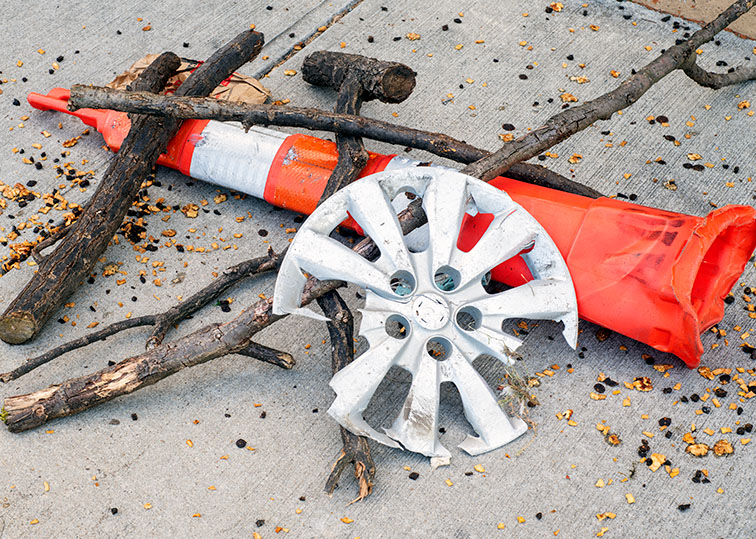
East Cleveland wasn’t really downtrodden until the late 1980s. It was a different place up until that time, and, of course, that was very different era, where good paying union factory jobs were always within walking distance. East Cleveland had one of the swiftest flips in racial history when it went from really white to really black. At that time the residents that live there in a much different economy could move on to the numerous subrubs it boredered, and the same Blaxk fols who worked along side of the whites, moved in as residents in East Cleveland replacing the previous class of people, but the Rust Belt was taking hold, and, by 1990, the city was in trouble. It was like the situation in the South Bronx in the 19970s and it blew up , in a long Rust Belt decline that it wasn’t eready for, but it wasn’t always that way.
E C Holes captures a peak in bad infrastructure from 2015-2019. Work has been done and, by, 2020, there was some improvement in a practically impossible situation. East Cleveland, hopefully, but, we don’t know, will stabilize finally, from a long downward slide of a once great and certainly historic place. I would say that with massive demolitions that began in 2010, finally getting rid of so many abandoned buildings, the city is going in a different direction now, and there are other things that are quite different too. But it’s still overshadowed by the great brute reality that is East Cleveland.
We could dispense with a lot of details about East Cleveland in this piece, because there’s a lot of things readily accessed on the internet about it. I’ll hit on some of those things that makes East Cleveland like no other, with the exception of its counterparts like Gary IN or Braddock PA, whose only difference is that East Cleveland was a true suburb, one of the first in America, and i’ll get there by literally examining the streets.
Places like East Cleveland and Yonkers unknowingly hurt their futures by beginning like small, but verdant cities attached to big ones. They included all classes, with the exception of anyone below working-class status who could live in the improved smaller city so close to their larger polluted cities that couldn’t keep out the riff-raff and poor. The wealthy wanted to live, early on, as close to the city line as possible, and so did the less fortunate, and the first suburbs built homes for all classes – except the poor and destitute. It was the first answer to the growing big city with its quiet, clean and orderly appeal, yet close enough in a train and horse and buggy era, to the city for working only.
But thereafter and years later, most suburbs would appeal generally to one class whether working or wealthy, and with the automobile, living anywhere in the county and commuting would insure rapid growth of multiple unique municipalities. Ironically it was going to be oil in the form of gasoline that would help ignite the suburban sprawls, and East Cleveland actually was the self-established original home for the person who owned most of America’s gasoline and oil. John D. Rockefeller, also a collector and breeder of fine horses with riding and coachman skills to match, called East Cleveland his Homestead, and even though he would be seriously disrespected by the city and county, so much so, to forever turn his back to his Homestead, and the city where his oil industry began, but only to return back to it, after his death, buried on the same high bluffs as his Forest Hill at Lakeview cemetery that borders Cleveland Heights, Cleveland and East Cleveland.
In a city, if you kept your eyes down to the street, you could tell a lot about it by the amount of its holes, their size, duration and depth. A city with big-ass potholes is gonna be different from one with none. A city that has the most and the biggest potholes is certainly one to look at.
To some degree i’m examining what’s considered one of the most deteriorated and financially strapped places in the country, through its potholes, but, i’m not out to inflate, what is actually so extraordinary on its own, is utterly visible and is common knowledge. As i said, it’s more to get you to search the place on the net, better yet go there and, through experience, you’ll see the level of truth i see. It’s not like watching, as one would on a screen. Generally E.C. Holes is pretty much just about the potholes in the streets of a real broke town. There’s only a couple of cities in America like this, and it’s about them as well – Gary, Braddock – built with industrial money.
Restating – E C Holes is specifically about an astounding array of potholes. If America loves superlatives, we can add this one – the potholes of East Cleveland are the worst, or, the best, depending on your predilection. And, of course, to be real, of all things the holes in the road are always temporary. The roads have been fixed to some extent by 2020 and the state had begun a traffic light replacement program, unfortunately, not before a tragic death or two. But it’s East Cleveland. Like any place the folks that live there, care, but it’s about money and not having it.
VIEW the slideshow.
I’ll hit on some of why this came to be, but it’s all there on the net if you search, beyond the urban exploitation, i mean, exploration sites. The idea of a hole and a fall into it, only occurred to me while writing this because shooting it is a different ball game and one should pay attention to one thing alone – the reality of EC, where you could really fall, in a hole.
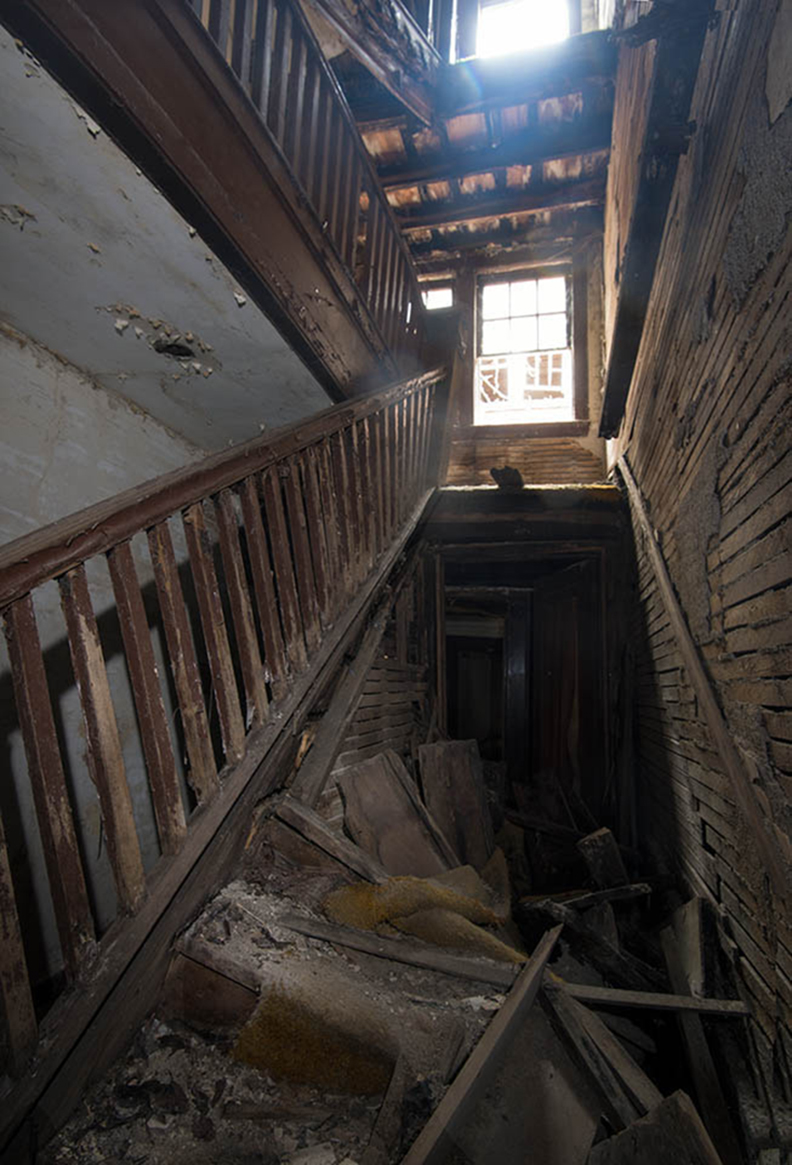
The worst street in East Cleveland is Chapman Avenue. I was almost to the third floor when the entire staircase collapsed beneath me. I was carrying a Mamiya 7 with a 150 lens and a flash, and had a pack on my back, which made it through decently. I bought a new flash, the surgeon fixed my damage, but i lost over six months work time and limped for two years after the surgery to repair my bones.
As always, i look at this situation as it manifests itself in the street and, this time it’s literally, the streets themselves, as they have opened themselves up in unbridled organic descent, like never before, because there is now nothing there to fill them up. Apparently there are places like instagram where you can view various older cities’ potholes and it’s becoming a thing. I submit these, thinking that EC holes are the worst, or best depending on your mindset, and reminding all, that it’s a regional thing – wild weather extremes combined with poor cities, and, as it turns out the Rust Belt has more of both than any place. The point is, if the most basic and fundamental infrastructure needs cannot be done to the foundation of the city itself, keeping others away and natives to stay, then what’s stuck will reign. The heart of East Cleveland is its many long-term older residents who all fit a pattern. They worked union jobs in industry – General Electric, General Motors, ad infinitum, surrounding the city itself in walking distance. Many retired with over fifty years of service to these companies. Their homes are well-maintained and they have lived in them for over fifty years, and go to their churches with love in their hearts. So the holes of EC are a shock to them as well.

“Pork Chop” is 91 years old, has lived in East Cleveland for over fifty years and retired from Ford as a union worker. Obviously he isn’t scrapping out of desperation but the joy of activity and the love of East Cleveland, not to mention recycling is good for the environment.
This is the big lost truth and fact of these types of devastated neighborhoods. Naturally, the media will only present the bad and titillating stories which occur, here, on a daily basis and, in fact, are quite outrageous, numerous and too much, but ultimately corporate media is there to sell products in advertising, and turn a profit for shareholders and owners, by increasing their audience share,as oppose to neeing there every day.
The only way to find out exactly what’s going on is contact. This is a lost art which the camera allows if someone lets it. The truth is that I have never met more union blue-collar retirees, than in East Cleveland, meeting people who had 40, 50 and 60 years labor at the factories, and were alive when EC was safe and humming, and saw the full extent of its decline, while always keeping up their homes and a kind of pride in EC.
A big part of EC – good folks who stayed because it was a good home, earned from working the factories. And this is the real thwarting of the drug-crazed stereotype of the city scrapper, by action and example, that you would never see by driving through or watching the TV.
I would suggest that historically, what’s American, is just that – hard work and a house to call home. Also i see blacks as being uniquely American simply from the generations who were brought here, at the founding and exploration of the nation, and have some of the densest and oldest lineages of all Americans. My family, parents and brother, arrived here in 1950, and, to me, it’s obvious. Ignoring the tragedy of slavery for the sake of this positive point about blacks, being truly American, and, until recently (hype, making bucks) producing solid authentic American culture, along with other tremendous contributions to fashion, sports, politics and science, as well as all the arts.
EC has an array of negatives from bottom up, and, for some of the last thirty years, from the top down. Excluding the sewers, i’m starting with the streets to the depth of six feet. I avoided shooting EC for a long time, mainly because technically it wasn’t Cleveland, but also it was more Cleveland than Cleveland, and didn’t want the extra level of anything-can-happen, an EC shoot would attract. But in 2004 i started shooting EC seriously, and it still continues today. I’ve shot just about everything worthwhile now, in 16 years – it is just 3.9 square miles. Briefly mentioning, that i have experienced the city of East Cleveland, off and on, for 67 years – Cleveland city neighborhoods, while impoverished and wrecked, are still nowhere near the level of East Cleveland, a city filled with both long-term good folks, who might be kinda stuck, or not, but it’s home. And there are more poor and even desperate ones who are there for cheap rents, starting with its very cheap weekly/monthly motels on Euclid Avenue.
Identity politics or culture is not what first comes to mind with regards to things i experience and shoot, the most basic of which is poor and working poor don’t catch breaks, and are broke – that’s all poor and working poor of every stripe. And only with unity which is different folks agreeing and acting, will things change. Interloper or buzz-talk rep, i am not, bringing years of contact and experience with the social histories depicted over time, is my job, in other words to tell some truth. and express some fact.
Power only begins and ends with class and human nature, as it reacts in situations, is what i see first, as well as the other layers – race, religion and gender are real, particularly race. What an obvious thing to say. But i see class, the money you have, as being so important. To be blunt, whether i agree with it or not, the message that the present system sends is – make money, it is possible, and leave these places because you can then afford a better place, not fix these places. That’s the brute fact, but people stay, and it’s one of the most native cities around, like Cleveland. And that attitude – pull yourself up – is what the D.T. – led party called being on the side of black folks. In other words, well – off people are telling the poorest – be like me and just make it. As we know, it ain’t that easy. It depends a lot on your starting point.
Some places have holes in the road.
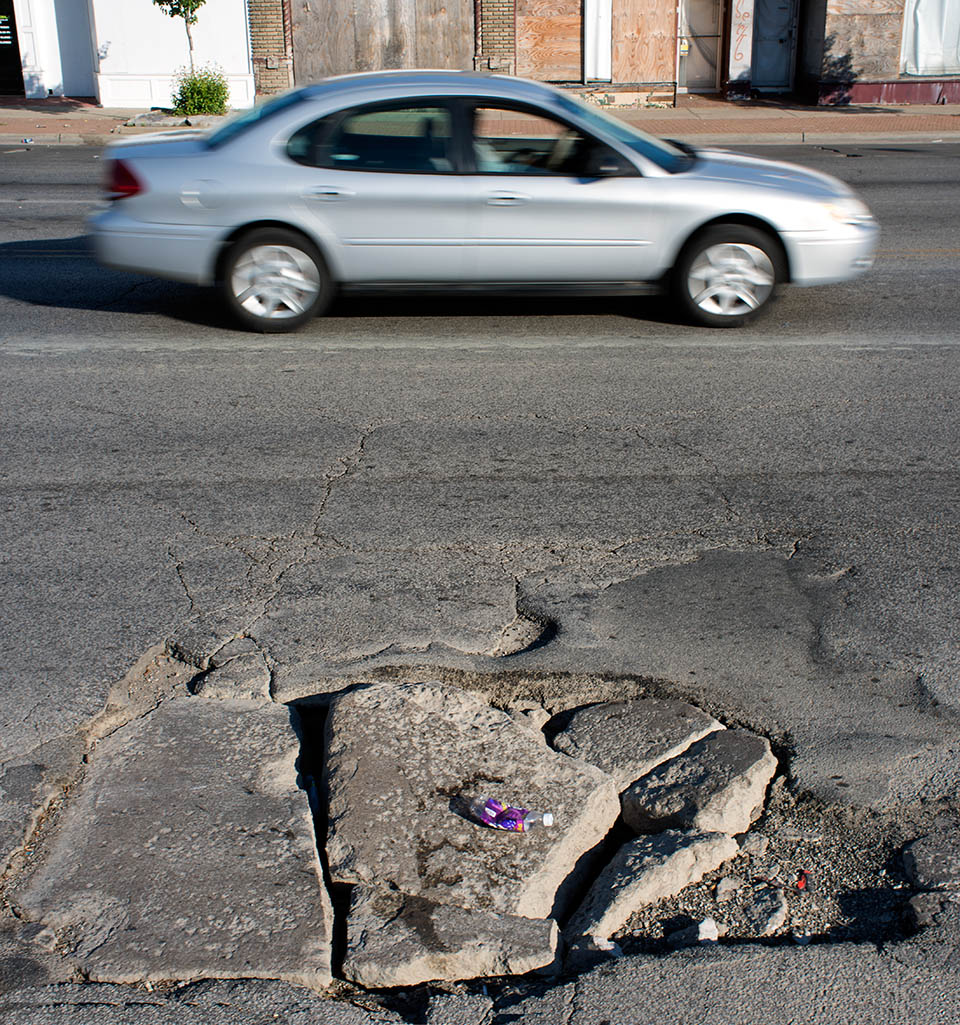
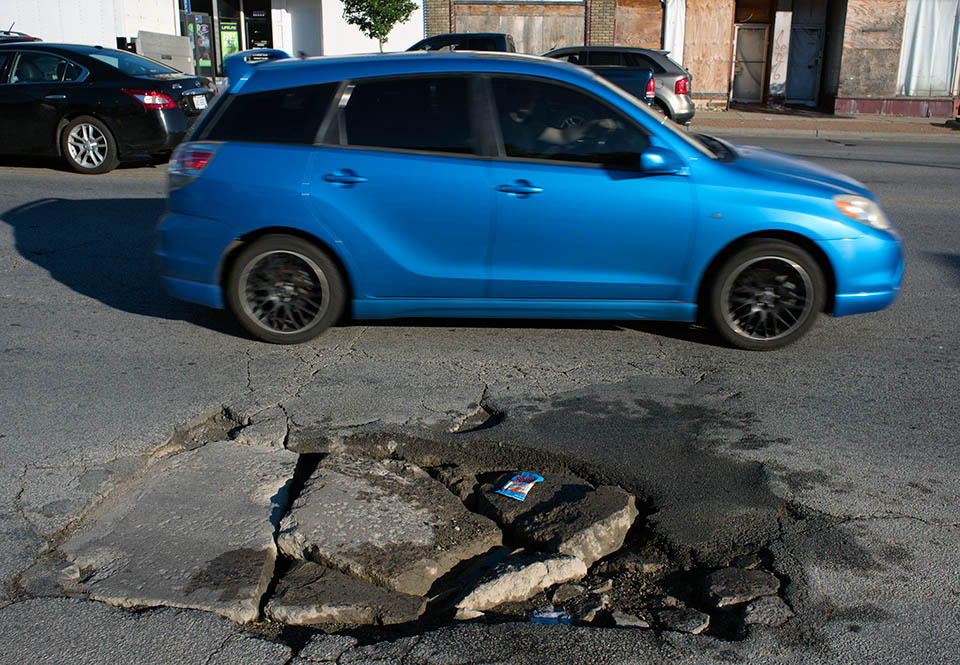


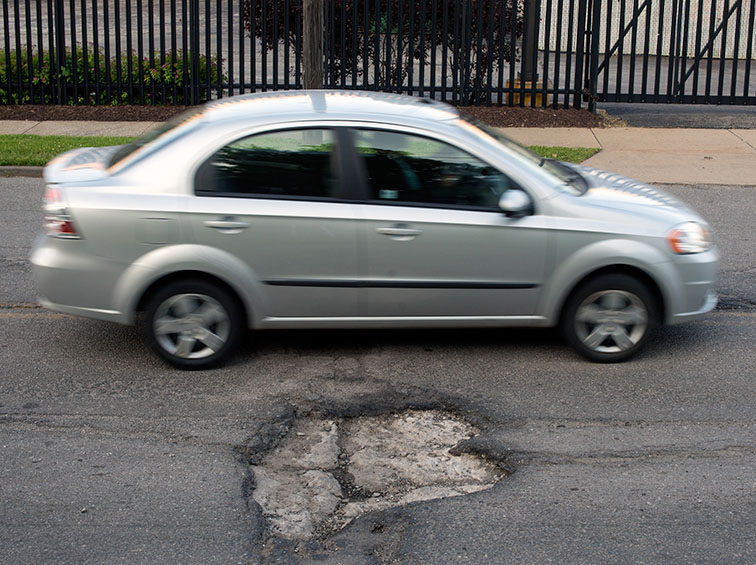
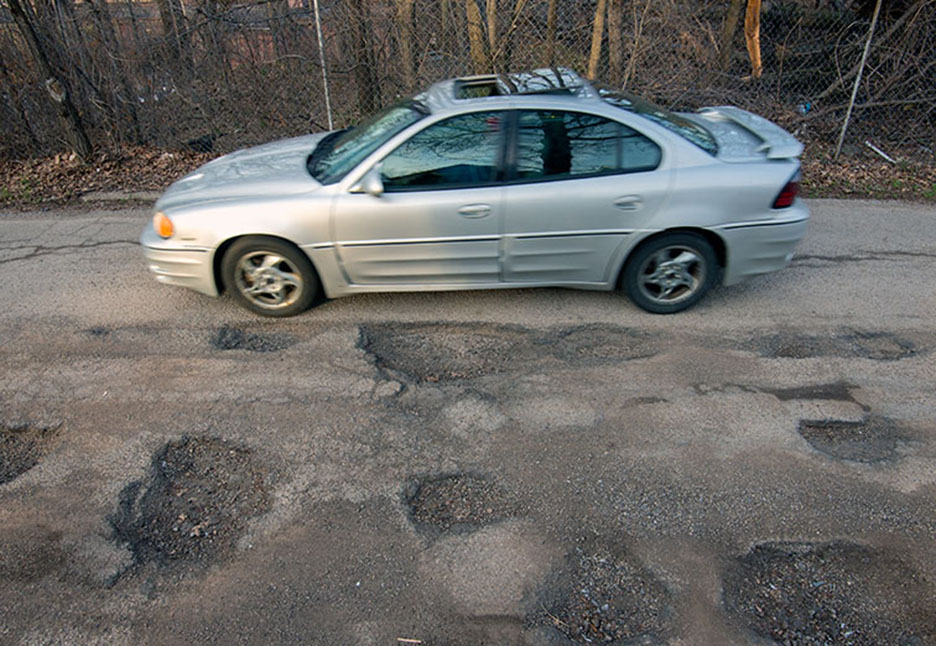
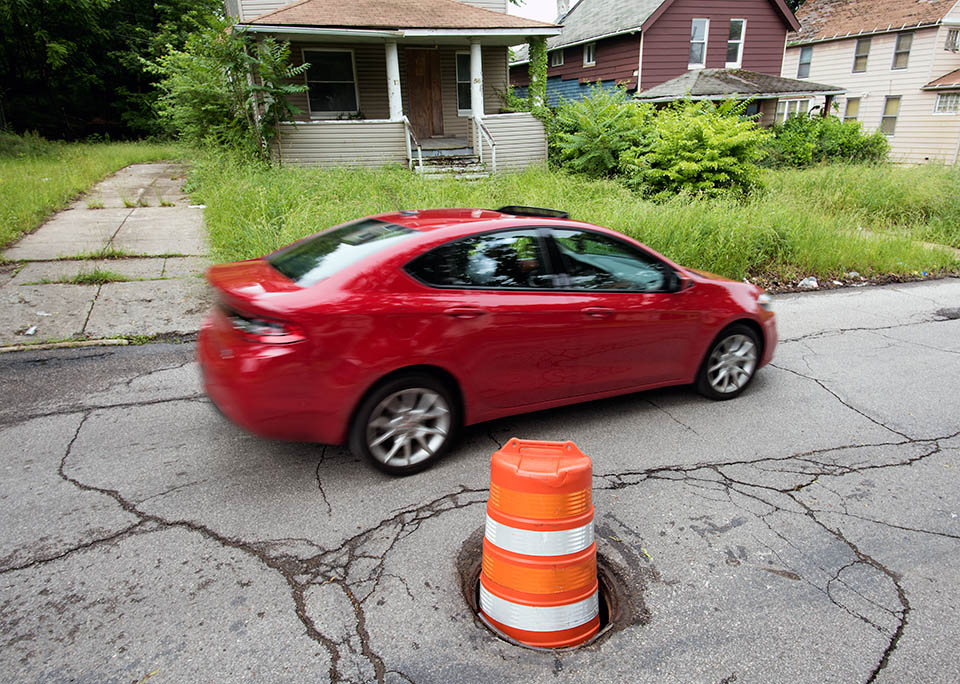
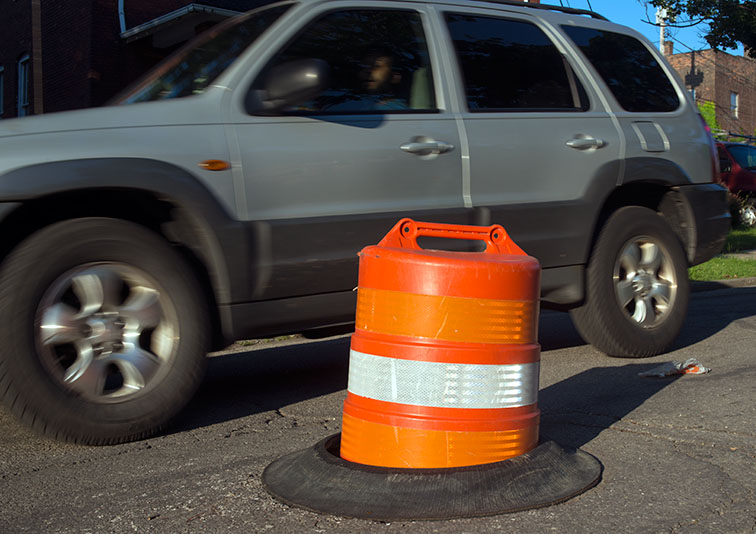

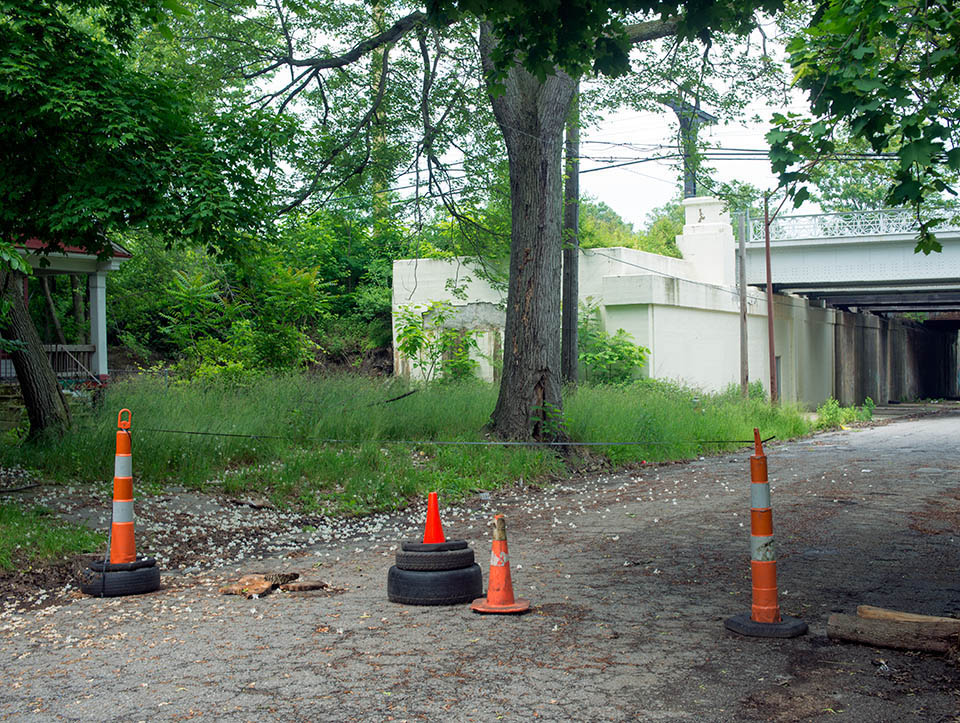


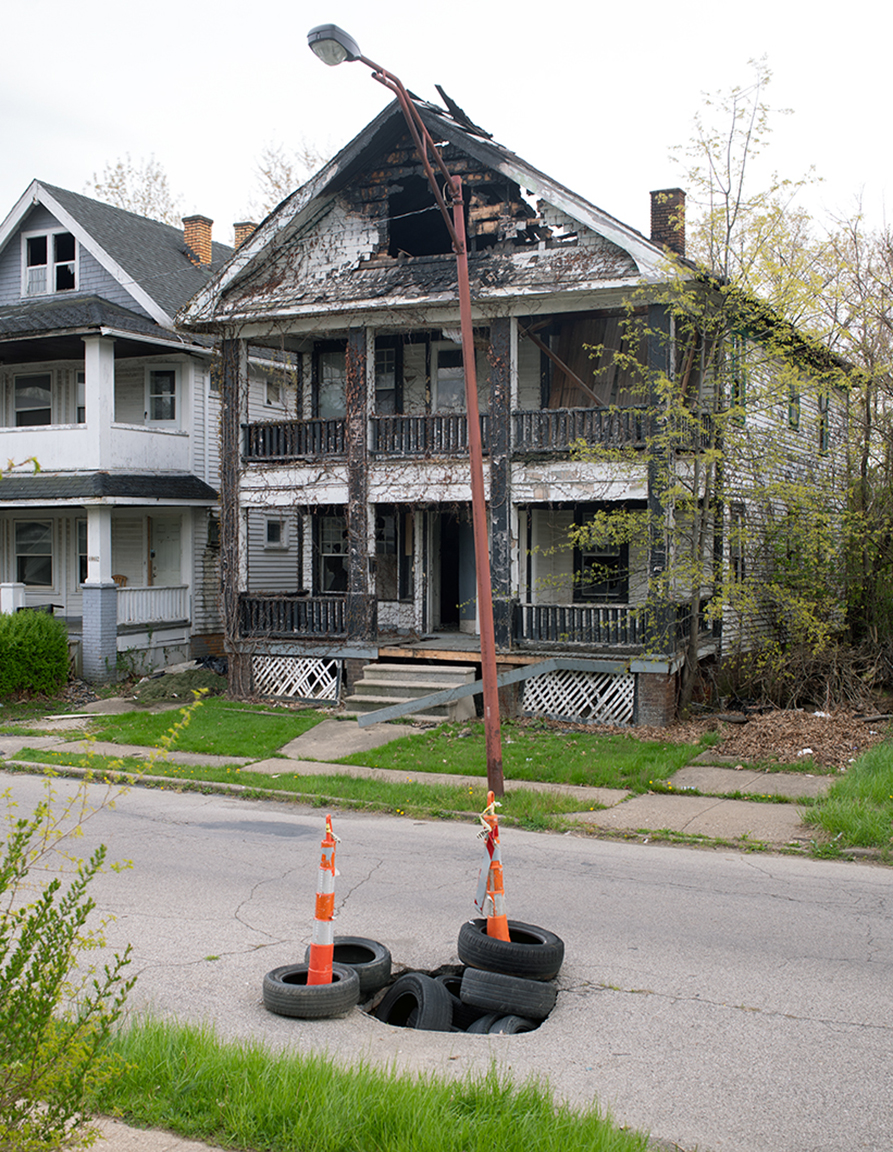
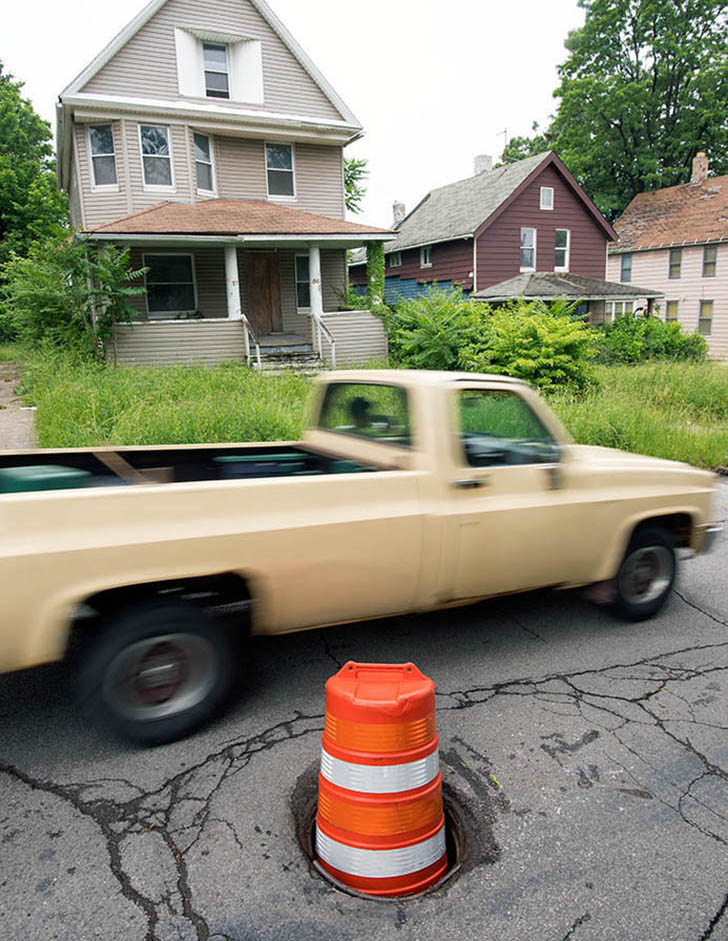
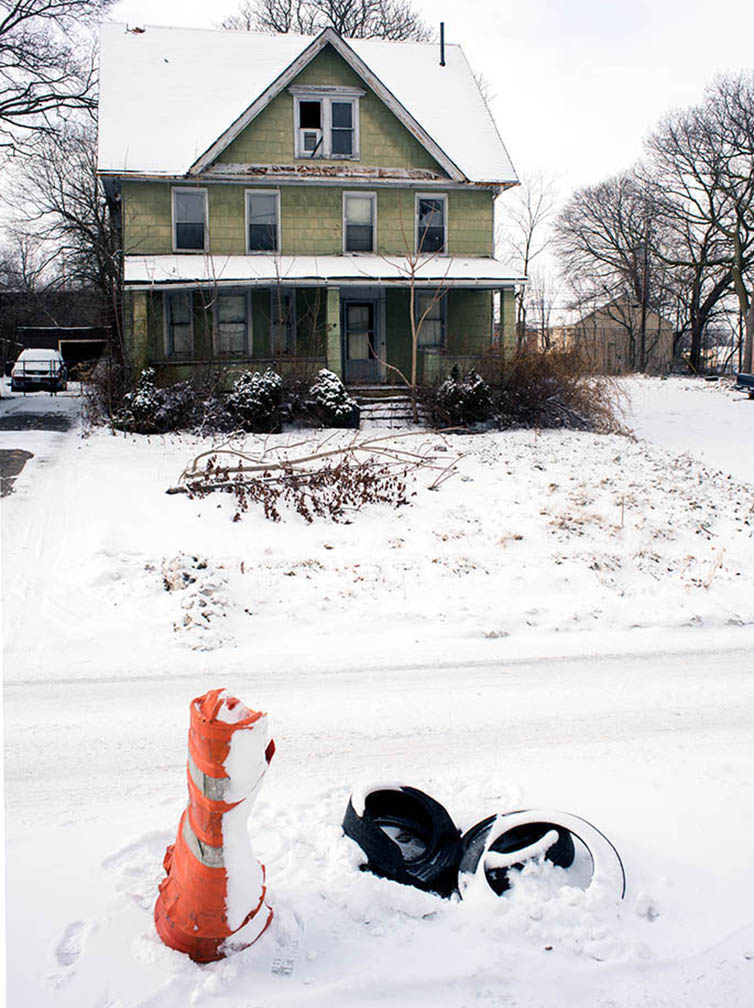


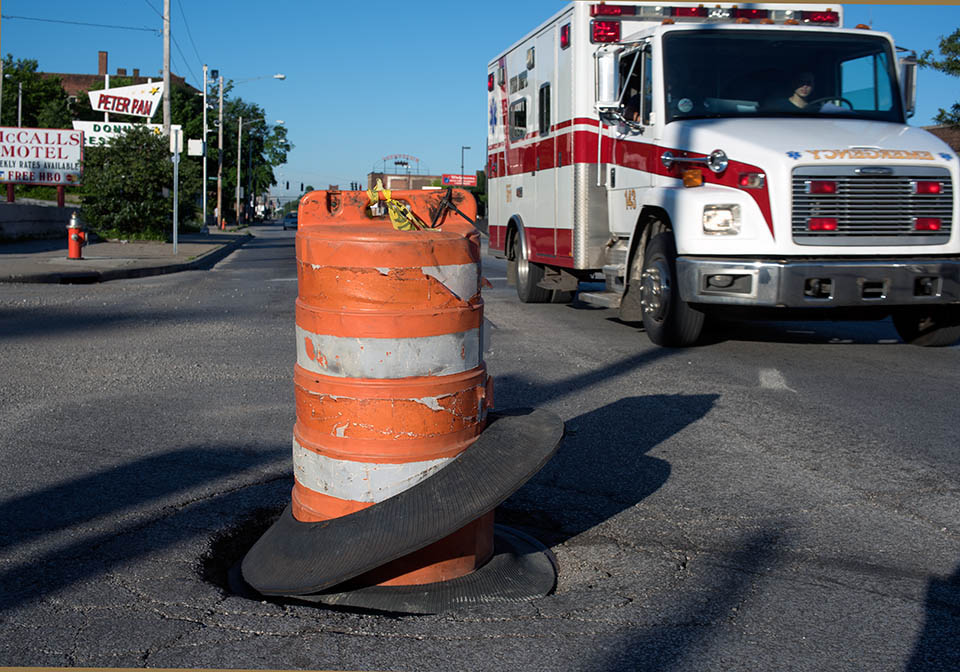

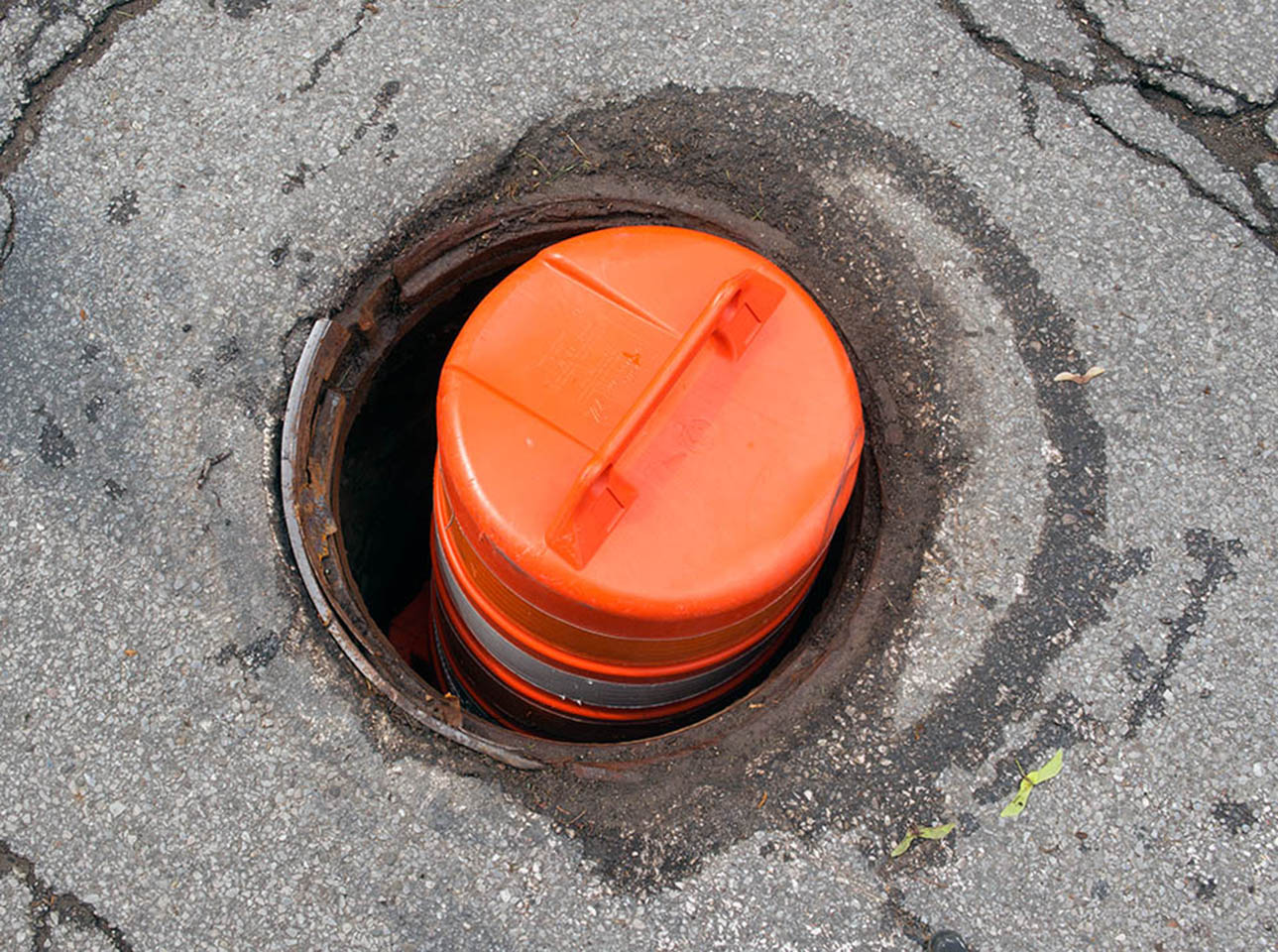

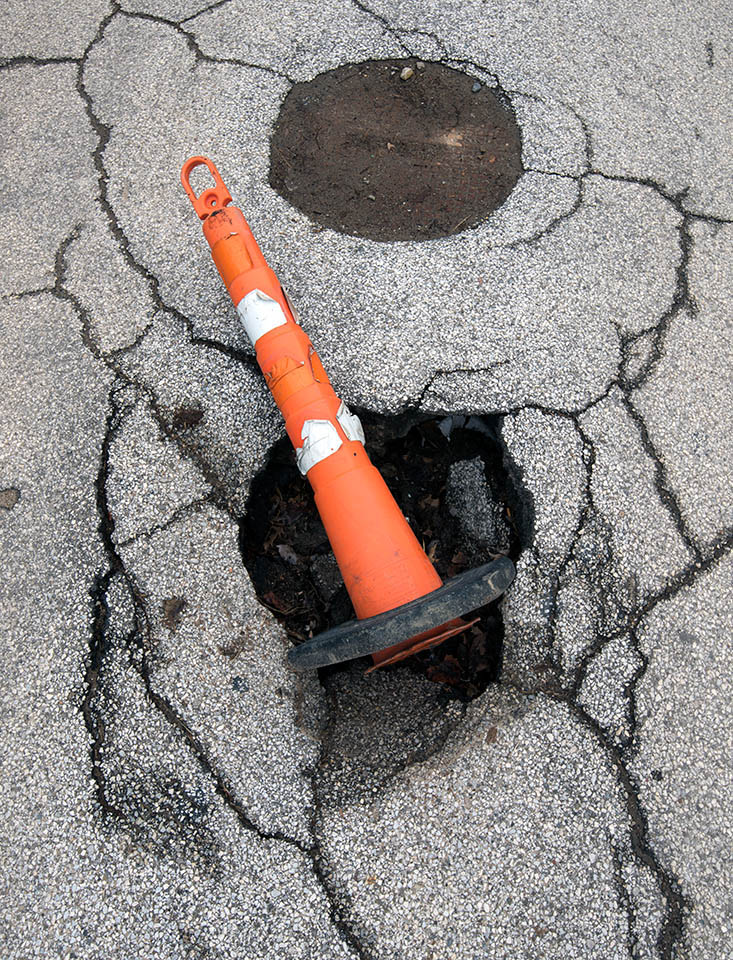

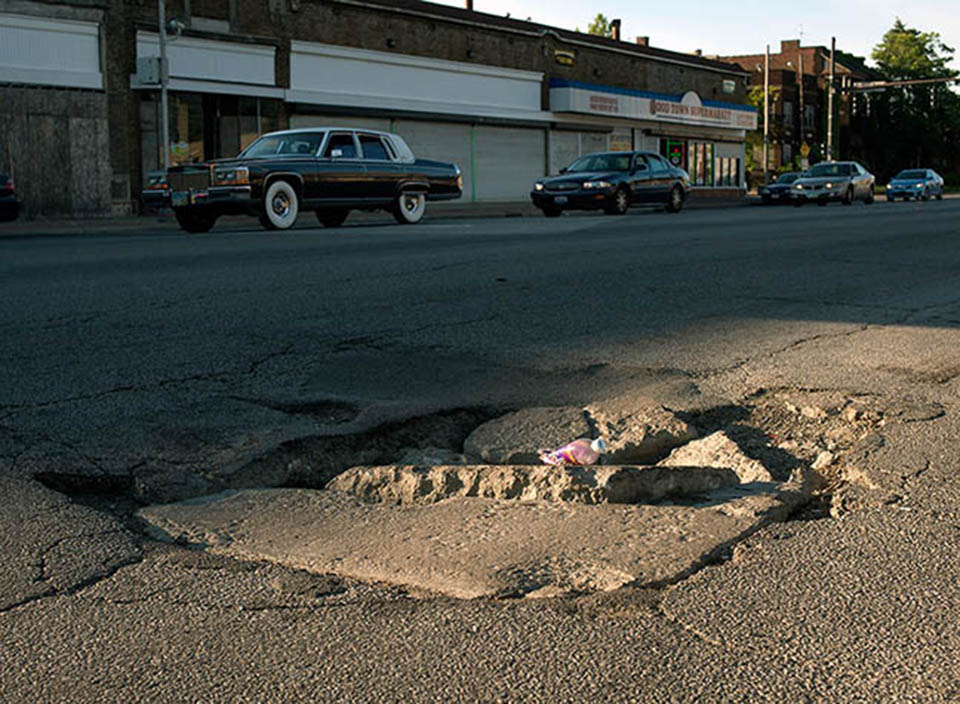
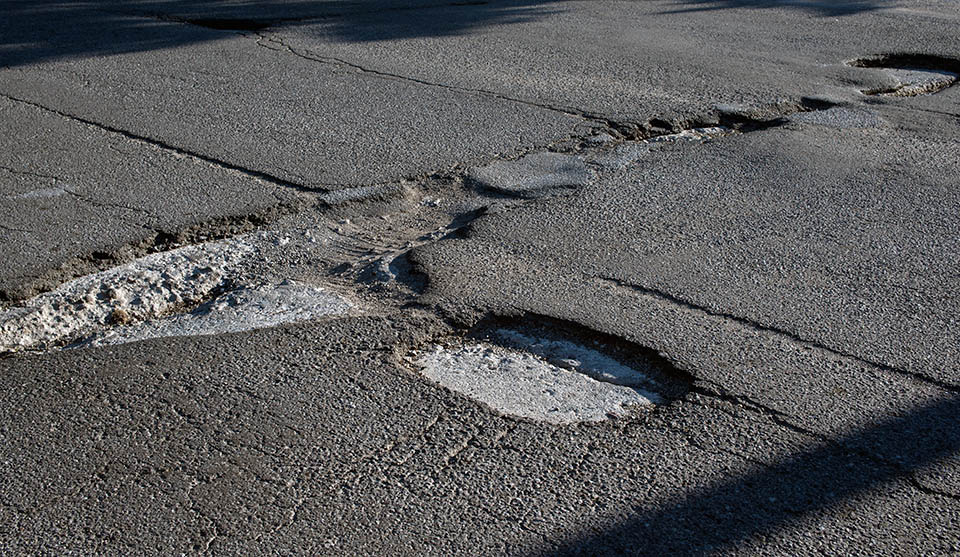


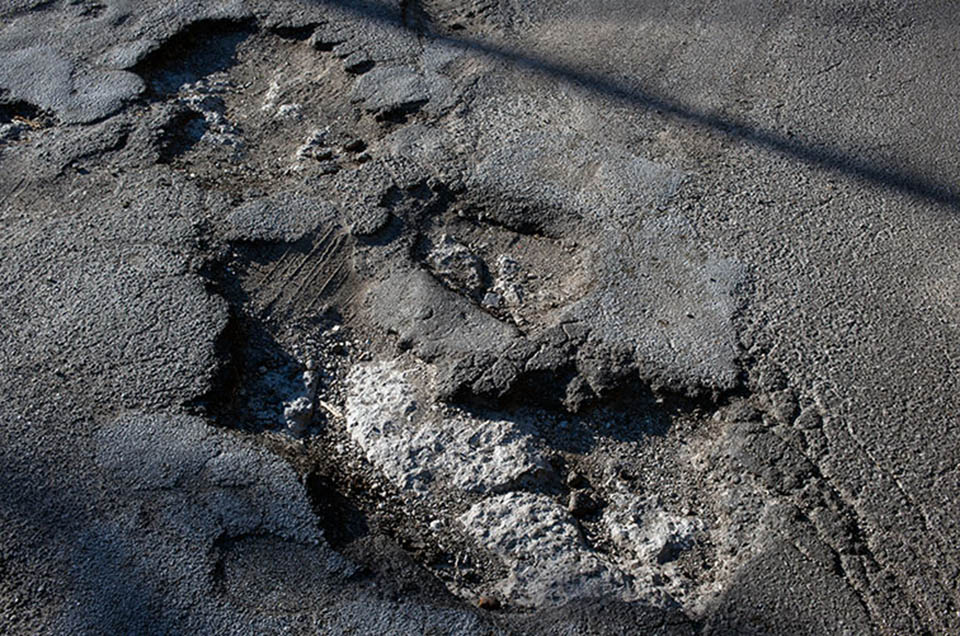

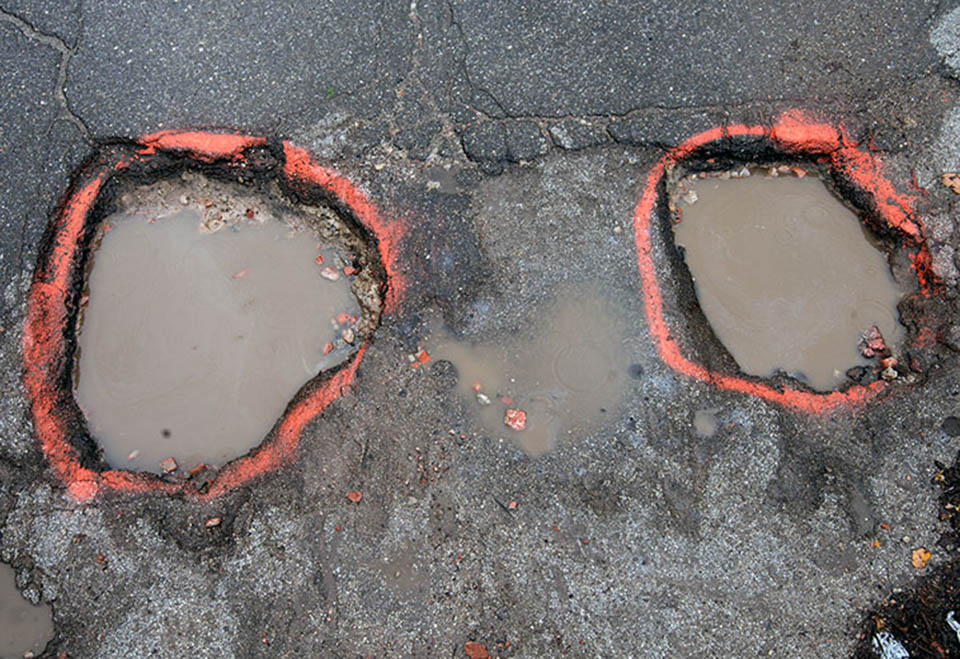
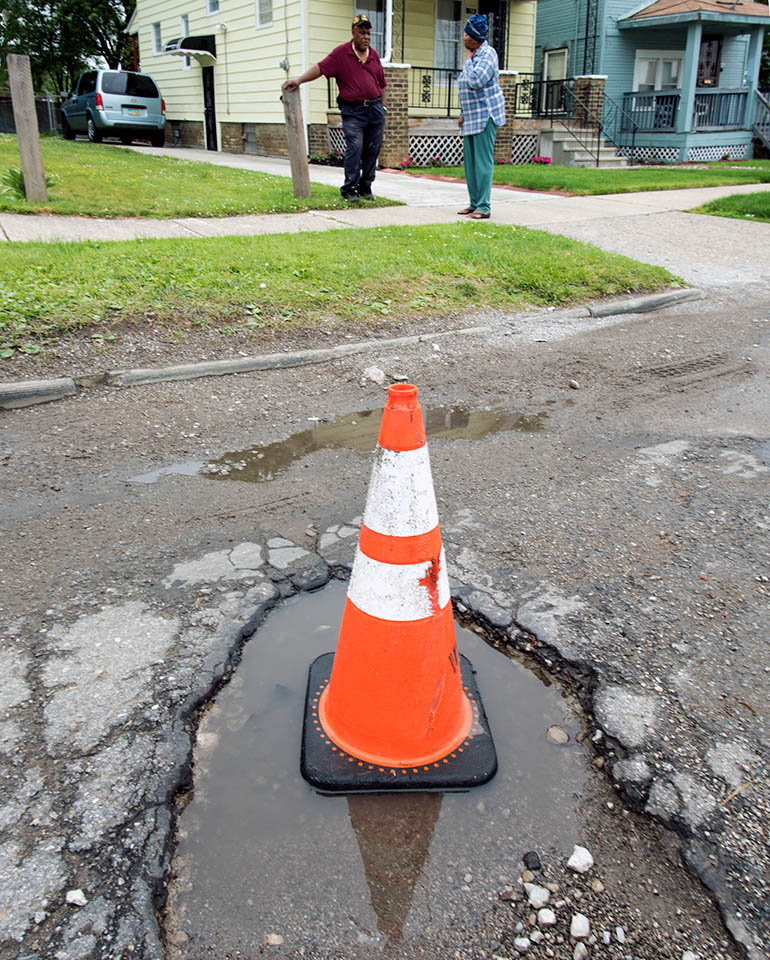

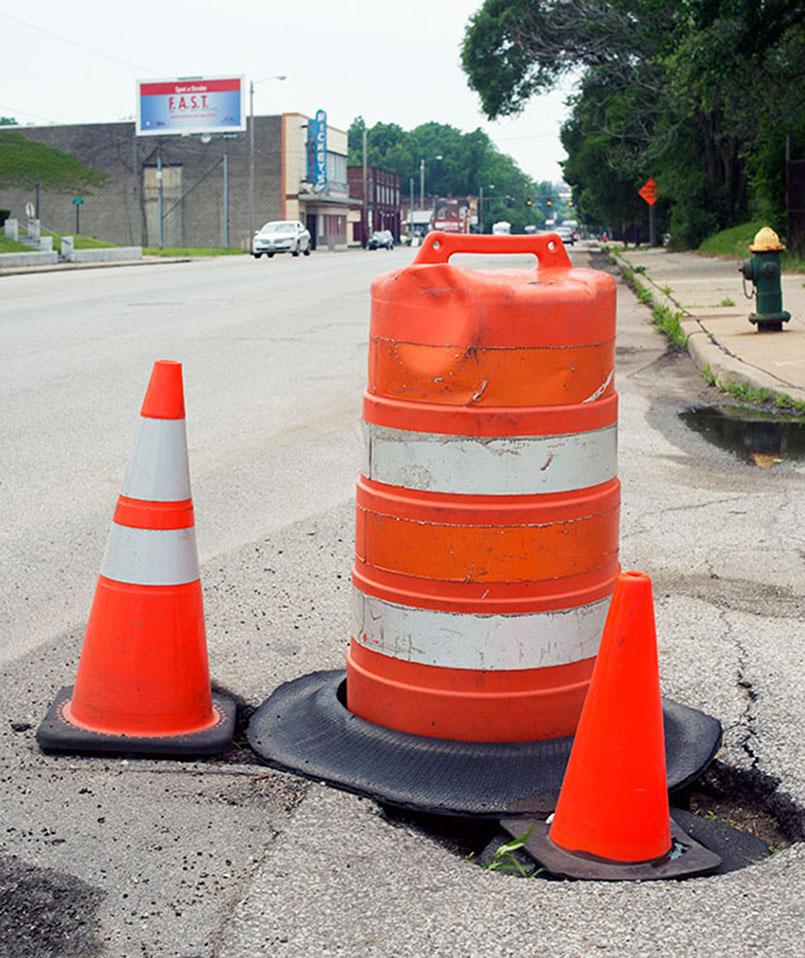


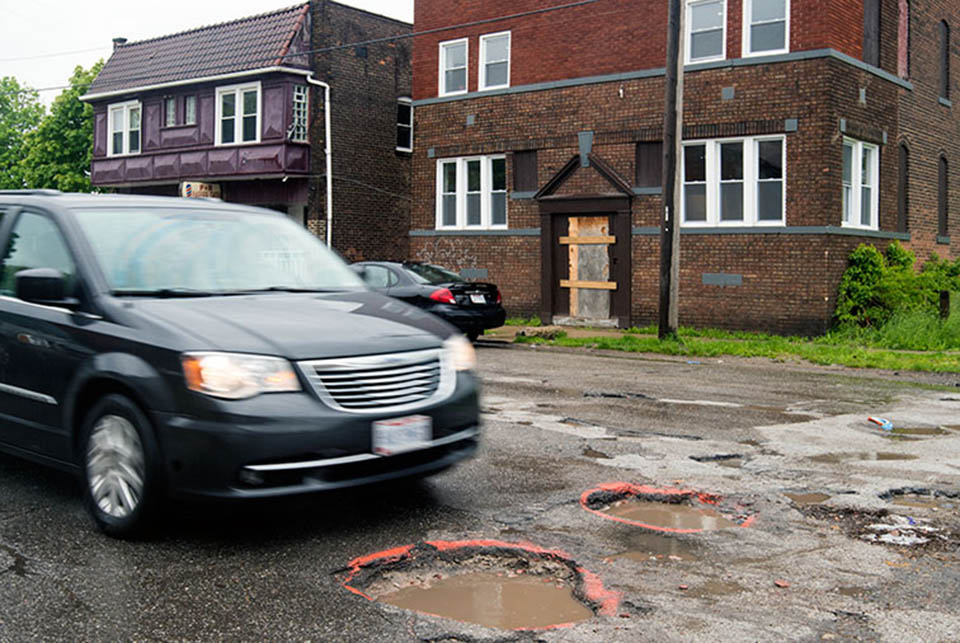

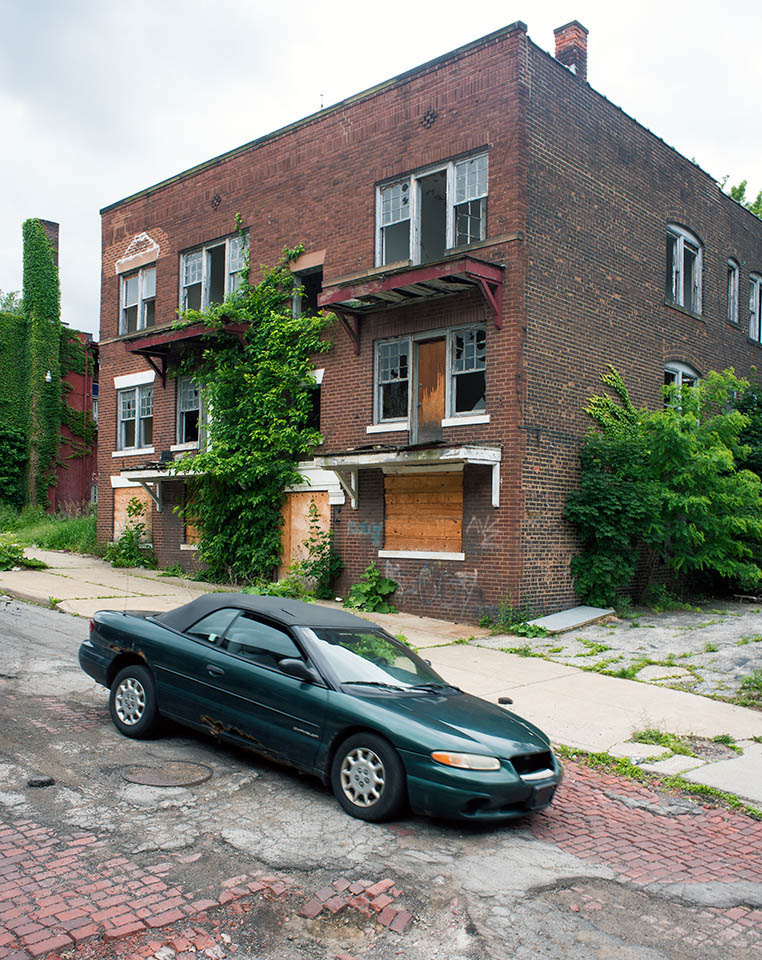
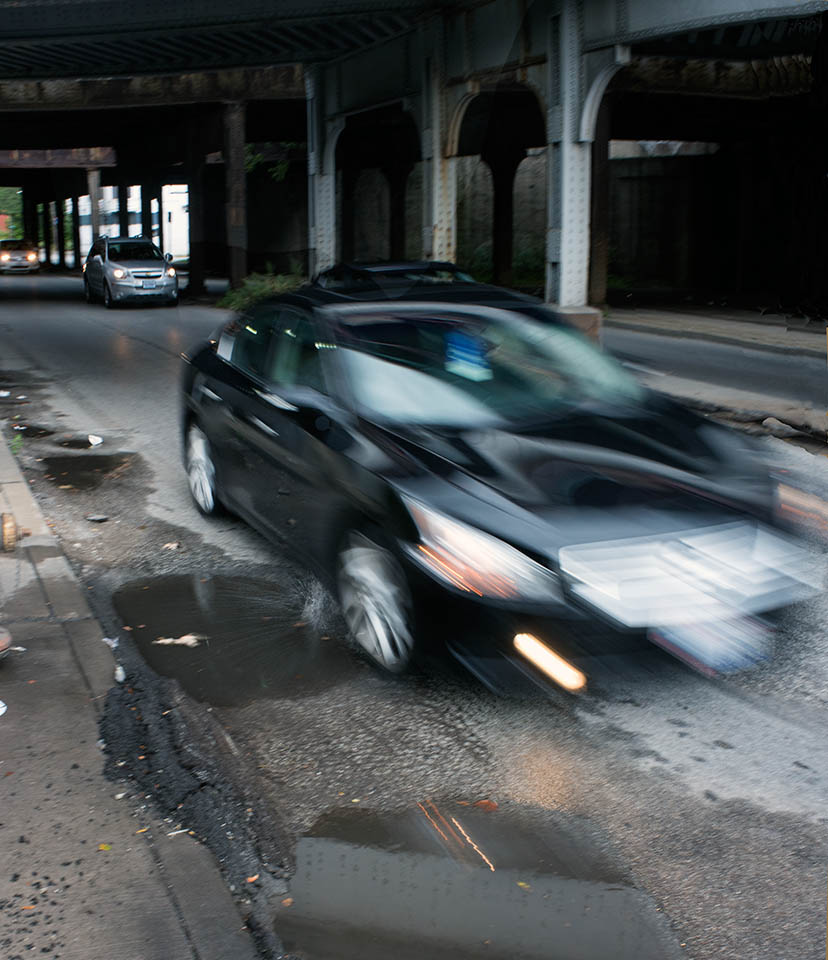
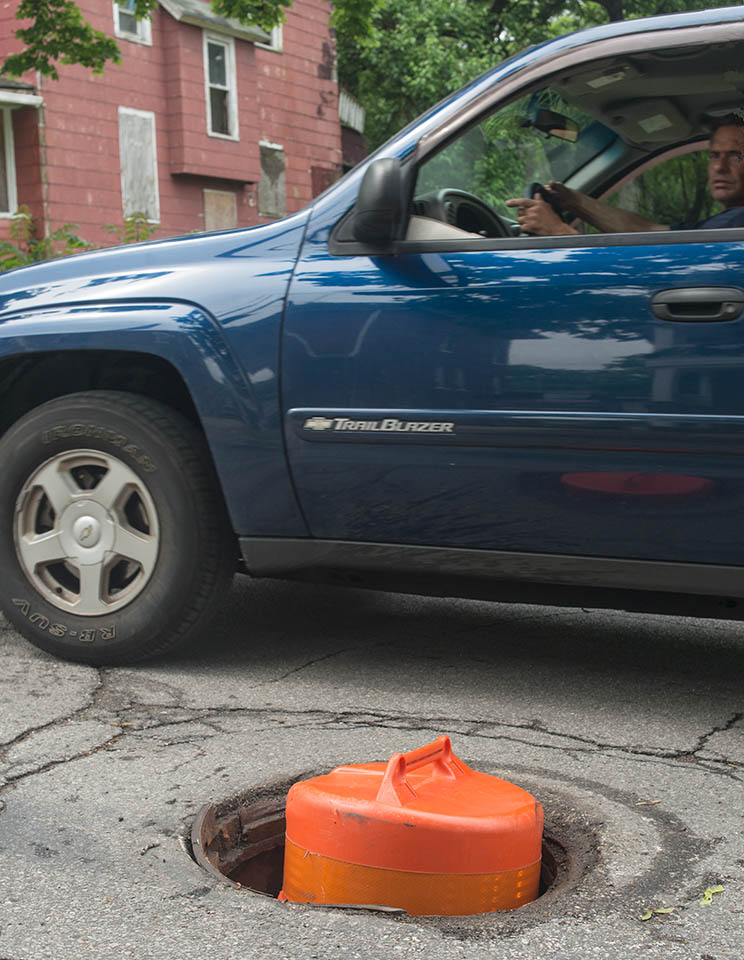

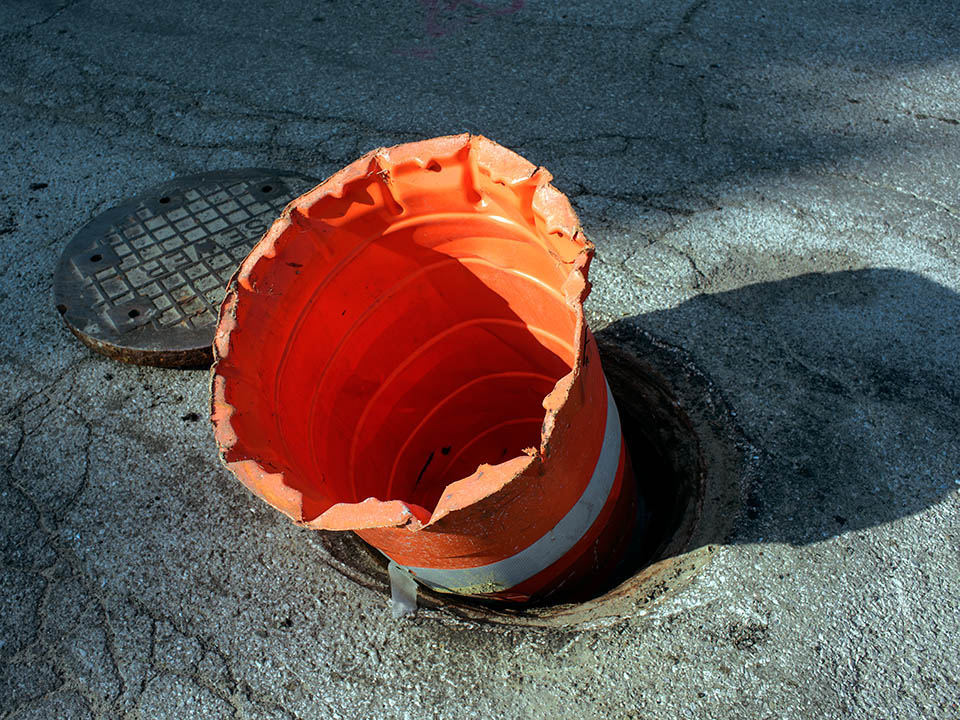
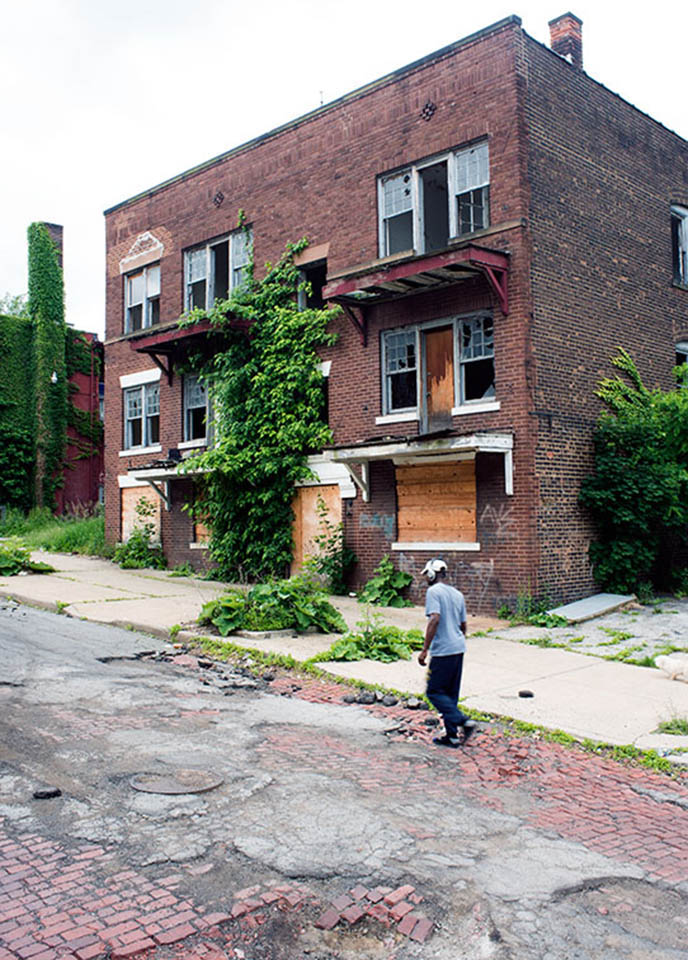

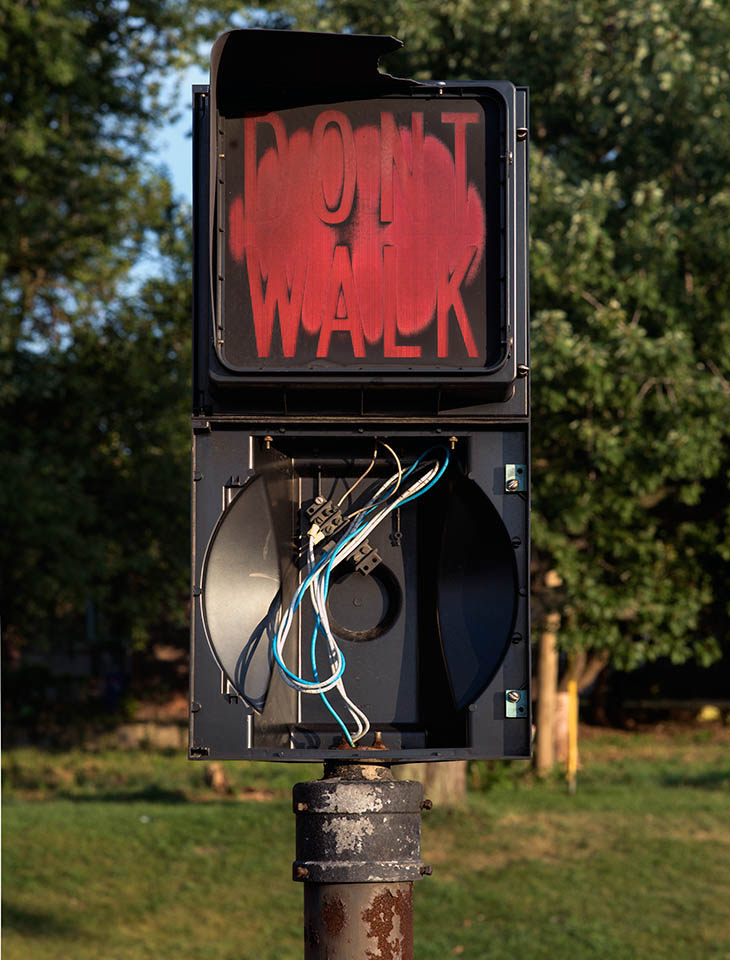
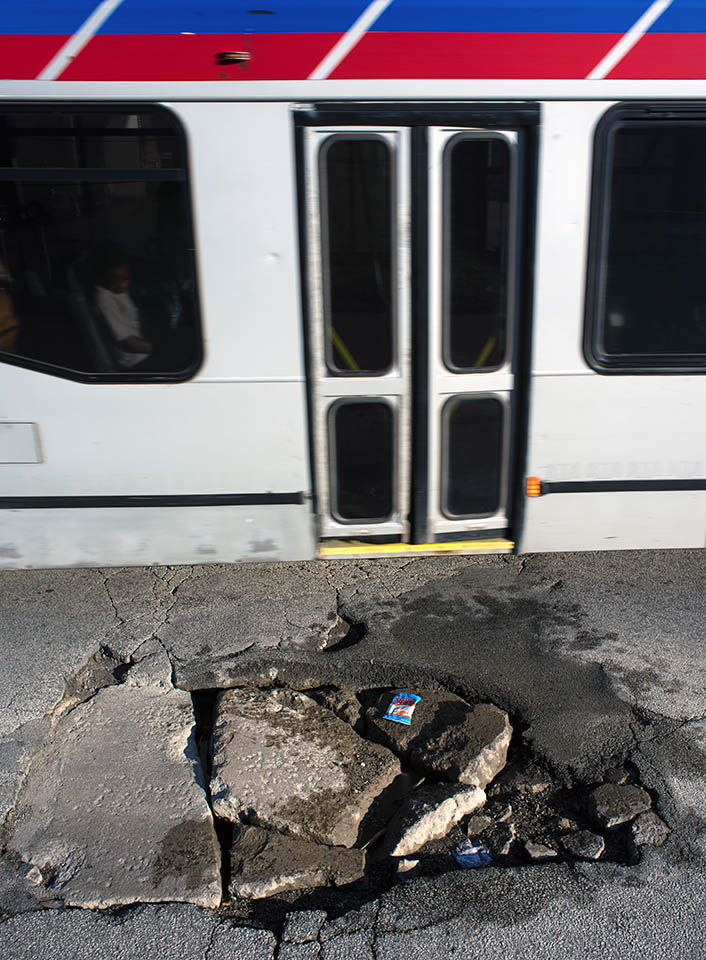


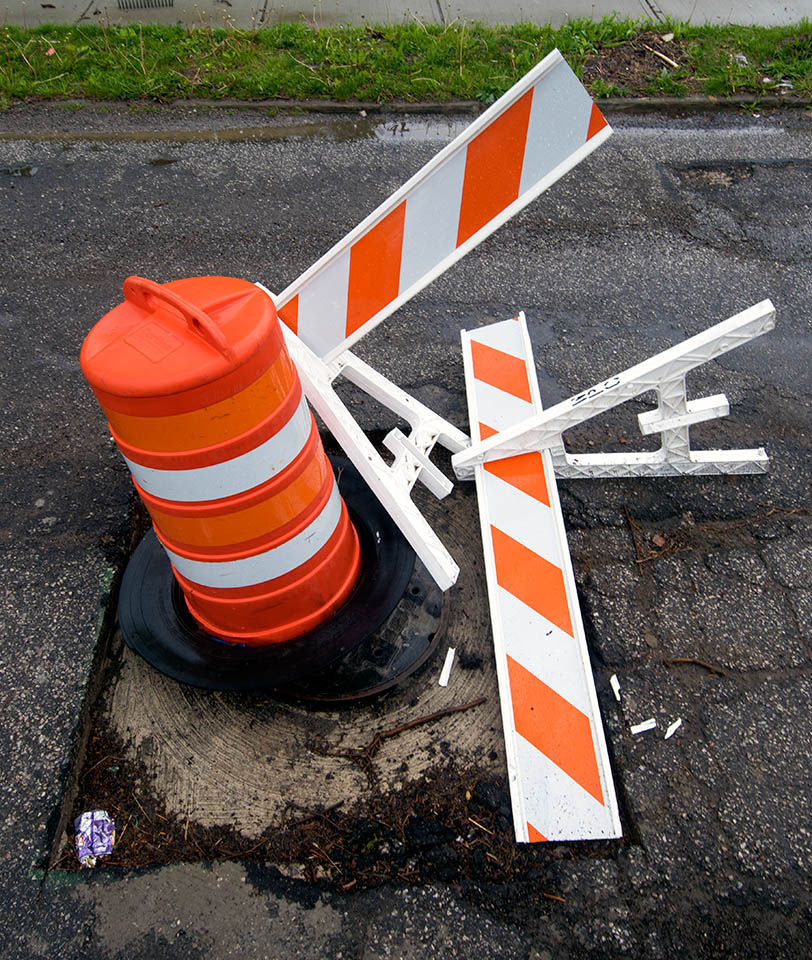


As a whole, East Cleveland‘s notoriety stems from the degree to which its own basic urban ills have manifested themselves, continually over many years without abatement. The problems are easily seen, have been recorded and documented but nothing helps. The city of Cleveland, in a very rare move, offered annexation to East Cleveland in 2016, where it was promptly voted down. This was also offered twice. 100 years ago when it seemed this was going to be quite a city/suburb, Cleveland wanted to get in on the action. Remembering the desperate ones probably don’t vote and long-term homeowners do, and that’s history at work, even though it makes little sense in every other way, when people live some place most their lives into old age, that’s it. It’s called home, and life ain’t eternal.
Most people avoid East Cleveland. Beyond world-class potholes, significant reasons for staying clear exist, but, just entering the city, if only to cross it, to reach another suburb or Cleveland, its University Circle or downtown, is such a slow hassle, one with undercover traffic violation cameras that were largely banned in the state, except here. You will definitely go around EC, avoiding it and the costs of robo-tickets, for the pleasure of taking its roads, with tire and suspension repair added.
Chances are it will cost you in East Cleveland. I received two robo-tickets for speeding within two years by extremely sensitive cameras that had been placed all over the city including roving mobile undercover spots complete with an unmarked corporate van of the entity hired to oversee traffic enforcement as a substitute for our government. That by itself is a giant constitutional insult, but to factor in the conditions of the streets, that force one to drive erratically, and its costs to vehicles, it becomes EC Absurd – a special category of the poisonous irony of what every day life can become because, generally, in the suburbs of the east side of Cleveland, individual people live in their own world, and, thus, are incapable from the get-go for effective change. Suburbs after WWII were built that way – as self-sufficient, but quick, clean and efficient strictly residential and of like income.
In fact, just like my documentation of the extreme pollution near and in my old Brooklyn neighborhood, i didn’t see the subject in terms of toxic waste or, like, potholes themselves, but representative of both the natural poisonous nature of many people, living in the hole of your own burrow and making, because that’s how you do it in the eastern suburbs, or any suburb – you’re on your own – there’s no regionalism here, or, as i say, the people of the eastern suburbs live in their own worlds, separate ones. That’s not possible in many places like Cleveland and all of East Cleveland, or New York City, that have wide varieties of income levels and whatever problems that might come with that, but there is constant daily contact outside the suburbs’ line of expereinces. Experience plays more of a role in ideas about cities than anything, so, then, where you live is important.
EC is a place, that people don’t drive through, but around. Beginning with its and Cleveland’s main thoroughfare – Euclid Avenue, which, through EC, is a slow, stop and go, 25 m.p.h. slow ride, with weirdly-timed and conglomerated traffic signals, while traffic cameras issue tickets, for the privilege of driving the most pitted streets around, that are bad for even a Rust Belt city, where they happen so frequently because people like Rockefeller located their industries where transportation was cheapest and weather was fiercest. The combination of old infrastructure and extremes of weather including terrible winters along Euclid Avenue and its cross streets in EC, requires upkeep, but for now, the skill of pothole slalom driving is required to avoid damage. And the only reason is the big one – no money, and, generally, no outside help, and, generally, EC’s own attitude to others.
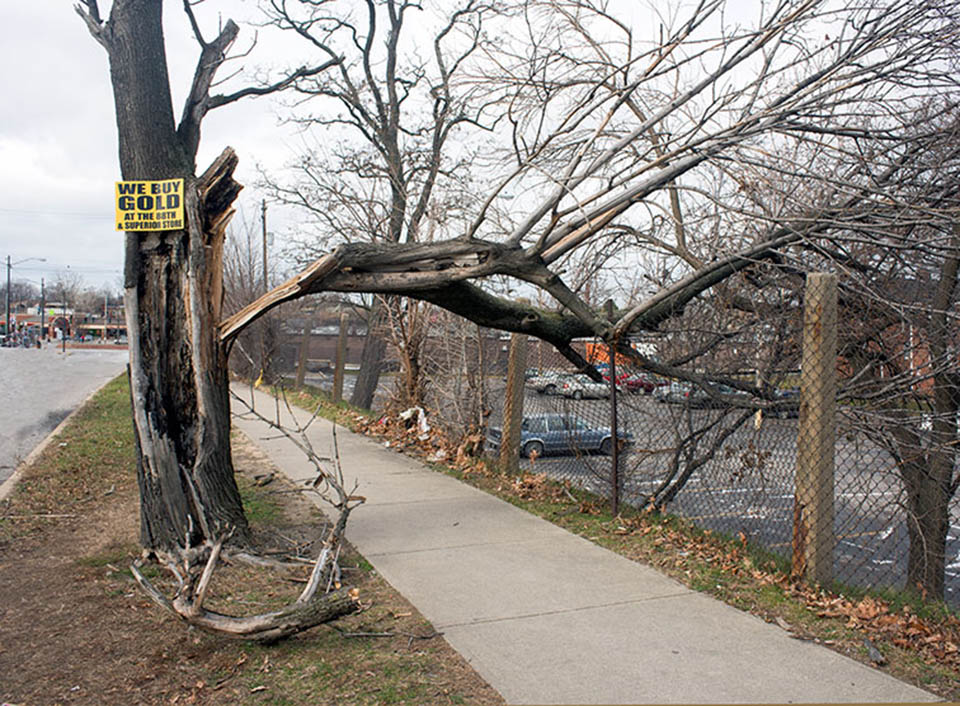
Response time to remove broken limbs and clear the sidewalk was nine weeks.
If people stop and stay in East Cleveland, it’s strictly the poorest, or poor, looking for the best deal on rent. It would probably be the first place you went after getting freed from prison or a jail stint or if you were broke. I’d say since 2000 many who were capable of moving did so, and they wouldn’t have to go far, as in most Rust Belt cities, the poorest sections can border much nicer inner ring suburbs, and, places like Shaker Heights, formerly the wealthiest city in America for many years, but still having one of the best school systems anywhere. The cheap motels that are nowhere else on Euclid Avenue but along EC and where it becomes Cleveland again before the suburbs, of course, wouldn’t be zoned into other suburbs that were built just twenty years after East Cleveland.
If you become a resident or have lived in East Cleveland or spend time there, slalom driving is the method used to transverse the city streets, often with braking to 5 mph or less to safely drive through the inescapable fact that one of the most troubled cities in America is reflected in the growth and quality of its potholes. No one stops here, but they would find there’s a lot of good long-term folks, who simply have to ignore everything to some degree and just live while maintaining their homes and driveways and sidewalks. But the holes of East Cleveland are the bottom end of the larger picture of the city itself. The most obvious being the fact that EC is, relatively and financially speaking, the biggest hole in the state, joining other Rust Belt casualties
The street holes are pretty interesting in and of themselves with their size, depth and quantity. But the city’s whole history, particularly its birth, when combined with the way the city has ended up, is closer to complete picture. John D. Rockefeller, who, essentially, founded the city, it’s first church and much more, was a consequence of him looking for fresher air away from the fanciest drag in Cleveland back then – downtown Euclid Avenue. His fellow businessmen all moved from what was then known as Millionaire’s Row, voluntarily abandoning it, for places that had not yet been built but they would start – the wealthier eastern suburbs of Cleveland. The first and closest to Cleveland, being East Cleveland that got its start because the John D. Rockefeller family liked it and their Forest Hills Estate would begin and span the growth of both East Cleveland and Cleveland Heights, while Shaker Heights, which reigned as America’s richest suburbs until the Rust Belt, was being built just south of Cleveland Heights. What distinguishes East Cleveland, being such an early suburb, was the inclusion of housing for all classes just like a small city. Ironically the man who began the oil and gas industry, fueled the growth of the true American suburbs, and, even before freeways, the far eastern end of the county along the Chagrin River – Gates Mills, Hunting Valley and Pepper Pike, were the, what might be called strictly big-time estates, and all friends of Rockefeller. And that’s what made Rockefeller’s move to the bluffs interesting. The Forest Hills home was first a commercial venture – a resort and spa – failing in its first year, they simply, probably, out of a good dose of convenience, moved in. I think there were sights set on the move to New York, though, otherwise, he would have had a more prestigious estate mansion further east in Cuyahoga county, but you’d have to be blind not to see where owning the oil industry could only lead. The banks and markwets were in New York, eventually, even equally wealthy men from the Montana copper industry, would end up on Fifth Avenue.
E C is a true suburb, one of the oldest and first, and, of course, is mostly residential, ever since John D. Rockefeller came here to get away from his downtown mansion in the fast growing city of Cleveland. It became more urban than suburbs that followed in the sense that it eventually housed all classes – in the mansions, including Rockefeller’s Forest Hills Home and the remaining Millionaire Row homes along the west side of East Cleveland just below the cemeteries, to worker duplexes, large elegant apartments and cramped plebeian apartment dwellings similar to a smaller Bronx, and many row houses. Generally the sections north of Euclid were working-class and everything south of Euclid Avenue into the Heights was middle-class/wealthy. But, as an old, first suburb of Cleveland, it’s always been urban in character, so much so that one cannot delineate the border crossing into Cleveland’s east side which is also considered ghetto – the Glenville section. Yet parts of EC do just about touch the economic engine of Cleveland – University Circle. And even Glenville, like East Cleveland, up until the sixties, was an often elegant place that was, in fact, as completely Jewish as it is Black today. That Jewish enclave spilled over into the western sections of East Cleveland.

Rockefeller, of course, was and might be, the richest American, even by our Second Gilded Age standards and even Silicon Valley’s. The Rust Belt used to be the center of industry and its technologies, as was the case when General Electric built the first industrial park and corporate campus, in East Cleveland in 1893. Even the industrialist tool and die makers, Warner & Swasey, having an optical sideline company, built their observatory and astronomical study center at the top of Taylor Road which was the eastern boundary of Rockefeller’s estate, on the bluffs in EC. It used to be that kind of place.
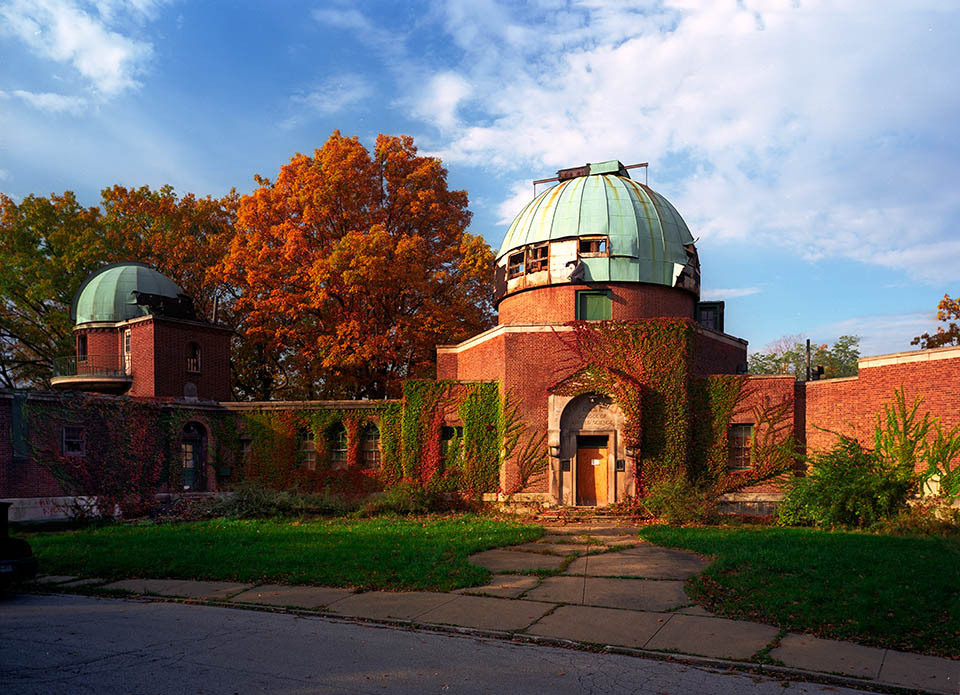
Warner & Swasey the great instruments and tool and die makers built an observatory at the top of Taylor Rd. Hill. The company was well known for their telescopes.Both Mr. Warner and Mister Swasey had mansions on Millionaires Road along Euclid Avenue, four miles further to the west. At the time of its construction it did not have light pollution that quickly developed around it as the suburbs grew.
Nevertheless the facility was taken over by Case Western Reserve University for a period In the 70s. By 1980 It was closed and abandoned until it was bought in 2006 to be converted into a residence for an east side Player, but family ran into problems and It’s simply went into ruin.
By 2016 all of the copper had been stripped off the domes. The place remains wide open and a wreck.
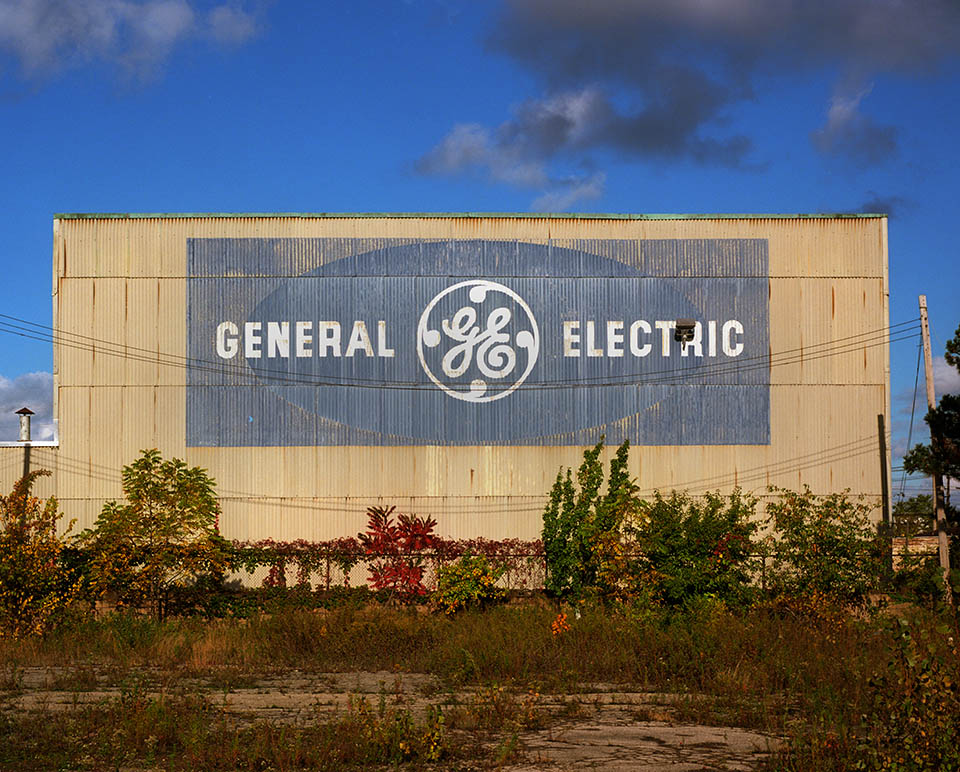
In 1898 General Electric built the first industrial park and corporate campus in East Cleveland, called Nela Park that sat on top of the bluffs along Noble Road. Beneath it and across Euclid Avenue it had a large bulb manufacturing facility and further to the north it had a huge complex of factory buildings including a glass plant.
This bulb plant shut in 1990 and sat like this until demolition in 2011. The open space is an old Manners Big Boy restaurant thet went in the early eighties. To the right was a commercial line of buildings including a movie theatre. Across the street from that was a bank and the best trains store in America in an historic old buiding that was a tannery and one of the city’s first manufacturing structures. Like the bulb plant they are all gone or abaondoned. Nela Park is still functioning on the bluffs, though.
John Rockefeller purchased the land along Euclid Avenue in today’s East Cleveland in 1873, before there was even a village. He and some investors opened a “water cure” resort called Forest Hill with a giant white wooden victorian mansion that catered to the newly rich industrialists and bankers. The business went under in one year, but the Rockefeller family lived there and also, four miles to the west in their Millionaire’s Row mansion. Their “country home” was called the “Homestead” and Mrs. Rockefeller, having raised her family there, was particularly fond of returning to what became East Cleveland, after moving to New York in 1884. The Forest Hills home then would become their summer residence.

The Rockefeller family, despite the weird treatment from the county and city, is buried at Lakeview Cemetery about two miles from Forest Hill. It also sits on the bluffs overlooking the east side and Lake Erie, just like at Forest Hill.
The family, with Mr. and Mrs. John D. Rockefeller in the center, are buried in a sem-circle surrounding an eighty foot obelisk. The gravestones are all the same – small and modest.
He lived much longer, better and happier in New York, where he died. But his wife and her mother had roots in Cleveland and the children were raised at Forest Hill.
Like the Rock Hall, they both, truthfully, belong elsewhere.
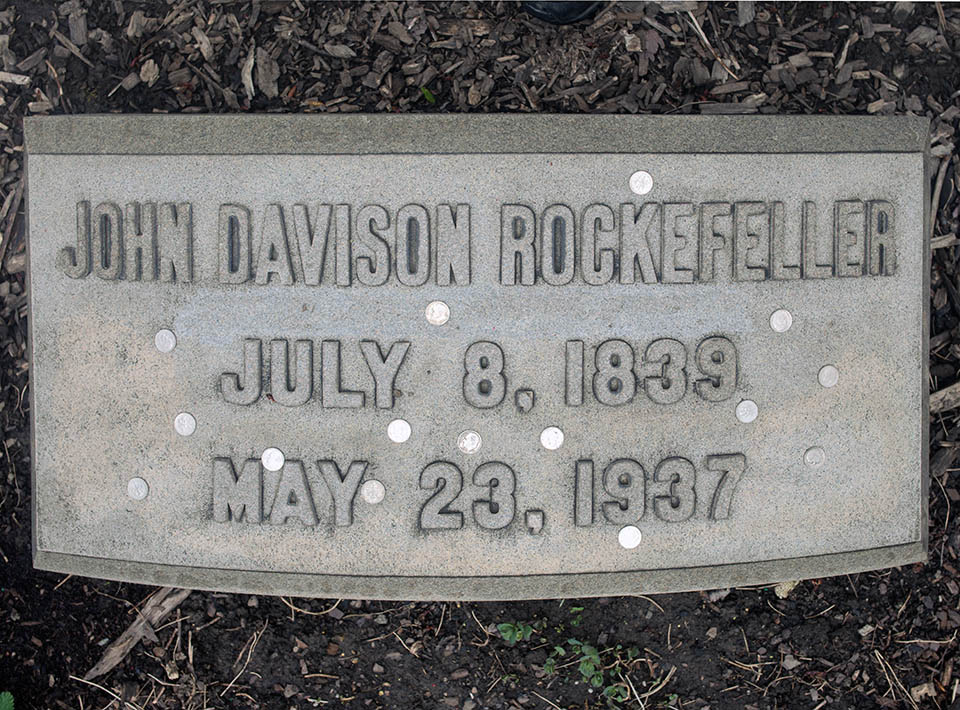
While John D. Rockefeller and family are buried in Lakeview Cemetery, bordered by Cleveland, East Cleveland and Cleveland Heights, after the death of his wife, Rockefeller rarely came to Cleveland. The mysteries of places like Cleveland or East Cleveland that ended up so vastly different then their original trajectories, might better be understood by examining the reasons behind John D. Rockefeller’s final reaction to a city that he basically founded and donated so much to – East Cleveland. It was one of America’s first suburbs, and in Cleveland – a large industrial city that seemed destined for unlimited growth, and, he left his mark. Standard Oil, itself, was broken into the world’s modern oil industry and there could be nothing, so basic, for so long, on a global scale then oil and its many ancillary industries, whose capital, thanks to John D., was Cleveland.

An original Standard Oil gas station on Euclid Avenue that’s been painted over continually but is still there. Predictably it had a Tudor design like a slew of them that were bult before the company became Sohio.
Classy gas stations with slate roofs, built like the nearby Tudor homes, is far removed from how gas stations, the city, and America has evolved.
The family would return to Forest Hill every spring and live there until the late fall. In October 1913 Mrs. Rockefeller fell ill so the Rockefellers did not return to New York until late February 1914. With the greatest excuse in the world for missing the deadline for residency taxes on February 1st, the County tax Commissioner still proceeded to bill Mr. Rockefeller $1.5 million for both residential and other properties, even though the family had already paid their New York taxes. Mrs. Rockefeller would recover but she never saw her beloved Homestead again. Because of the tax dispute that Rockefeller eventually won, the family stayed away in 1914 and Mrs. Rockefeller would die in the spring of 1915.

Dugway Creek was one of a number of creeks that sliced through Forest Hill. Only one, Dugway, is daylighted, in what is now Forest Hill Park, but only for about a thousand feet before it goes back into a culvert until reaching Lake Erie. Dugway Creek ran down a ravine just west of the Homestead and was free-running all the way to the Lake.
Just after farming, the original use of these ravines along the bluffs of Cleveland was mining bluestone in quarries. This type of sandstone, as well as shales and slates form the bedrock of the area, and are the western end of the Marcellus deposits, the stone providing material to build originally, and now is mined for its oils by fracking.
Rockefeller’s most bizarre business move was originally opening Forest Hill as a water spa resort which lasted one year. America was still in a train and horse era where proximity to the downtown business district was still necessary. Oil would soon become a necessity with the automobile which allowed suburbs to be anywhere in the county and workers didn’t have to live near work and they could easily commute. So poised was Rockefeller, that he had control of the entire oil industry even before the gasoline addiction tied to the rise of the automobile took off.
Ironically the man who fuels the auto industry would drive his horse and buggie from Forest Hills, down Euclid Avenue to his headquarters, and back, and was good at it.
Mayor Bloomberg of New York can pilot helicopters in an updated version of the skillfull tycoon.
In the wilder sections of the park it becomes clear, that even in the prosaic landscape of northern Ohio, there were idyllic and verdant places, particularly along the high bluffs of, what would become, the Heights’ suburbs.
East Cleveland and John D. Rockefeller, had a history of generosity to his city, less, after he successfully won against the insult of the county’s tax claims. But only because it was his son’s idea, would Forest Hills grow into a park and beautiful suburb. The Homestead at Forest Hills burned in 1917, no one knows how. Later his son would buy 63 acres from his father to develop into 600 fine French Tudor homes. Only 83 were built, but a fine neighborhood called Forest Hills grew up around it. Like many eastern suburbs and his family’s old summer home, it sits on the bluffs that look over the east side of Cleveland proper and Lake Erie, and its geography has kept it a world away from EC proper below, even though they share the same school district and taxes.
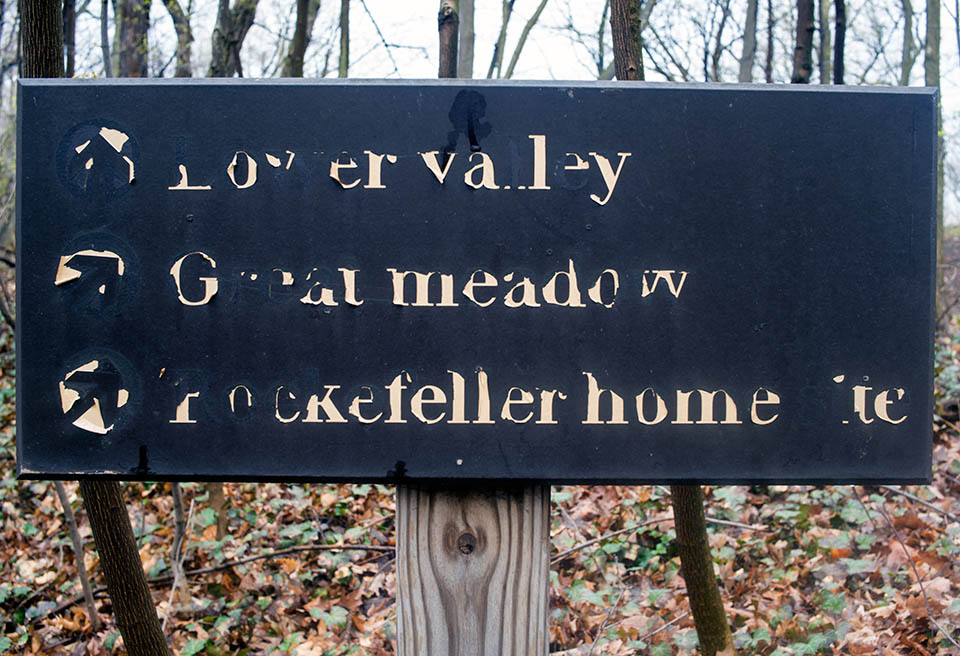
Forest Hills Park was created from a section of the original Homestead. The original structures have all been lost except for the one room ruin of the blacksmith shop. When cities woke up to the idea of history, culture and arts districts, Forest Hills Park installed historical markers.
I don’t mean to pick on them, i really like the park and efforts are always ongoing to maintain and reclaim it. Unintentionally, though, it accurately reflects how Cleveland and Rockefeller both felt about one another after he turned his back on the region – forget you.
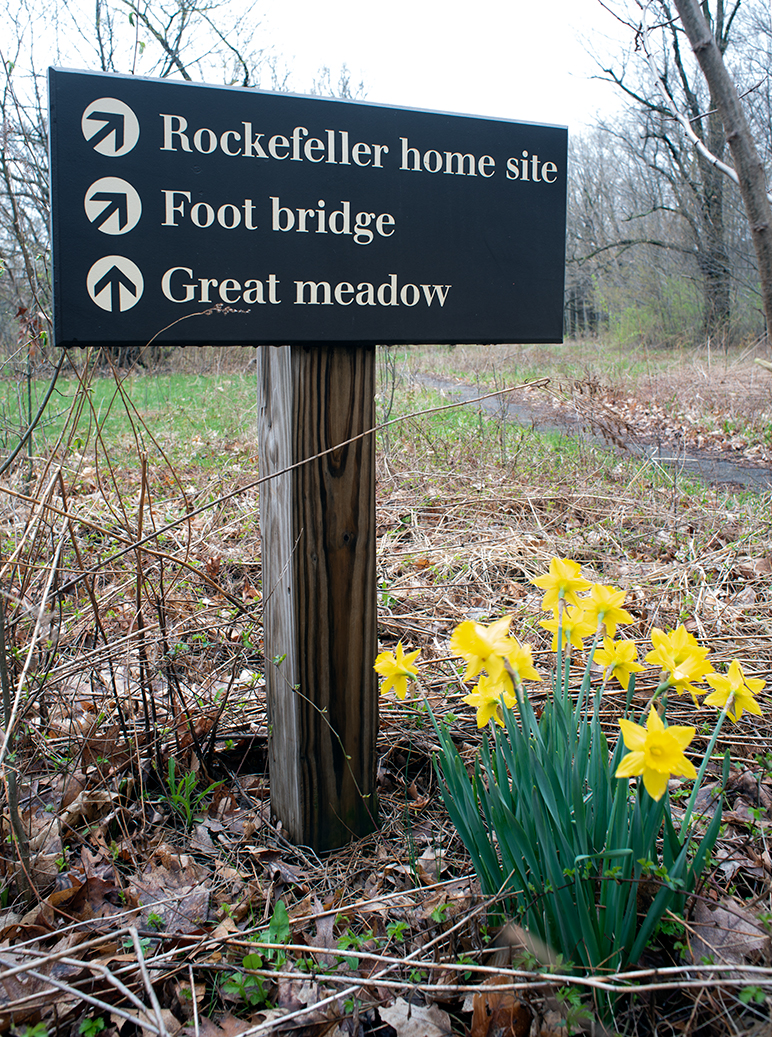
No one’s trying to pick on or dump more negativitty on EC, i mean, it’s really not necessary. In 2020 this new sign and landscaping was installed. It’s a tough job, keeping John Rockefeller’s former estate maintained. Hell, the fire department had to cut the grass and do landscapiung for some years back around 2010. Ninety five per cent of the municipalities in America accept keeping parks maintained as a given.
In 1939 John Rockefeller Jr. would later donate 235 acres of the estate to the two cities of East Cleveland, after his Forest Hills development had petered out from the Depression, for a public park. The basic park remains, but structures like the stables, much landscaping and lake were allowed to organically descend. But his father had turned his back, or, at least, his interest in both East Cleveland and Cleveland, probably damaging it in the process, but certainly no one could stop the precipitous fall of industry beginning in the 1970s, even the people who invented modern industrial America couldn’t stop that, but at one time Rockefeller’s final exile from Cleveland could have been halted, and, yes, the Rust Belt still would have washed industry away, but Cleveland would have been better off, as John D. began the University of Chicago, etc., giving away half his fortune – 530 million – to places that respected what he had the ability to do and had done so well, and not suck him dry.

A tree has fallen from the Cleveland Heights side of Forest Hills Boulevard. Across the street is the East Cleveland section of the former home of John D Rockefeller and family, Now known as Forest Hills Park. The Forest City is Cleveland’s nickname for over one hundred years. The fact that the city sits in a zone of weather that batters it with storms during all four seasons plus the fact the trees of the forest city we’re allowed to grow wild, as if it was a national Park, creates problems. The numerous power outages occur because the electric lines run above ground on wooden poles, and are being damaged by trees falling into them. The massive blackout of 2003 began in Ohio, close by, when a tree branch fell on power lines.
In widowhood, Rockefeller told a biographer, “Cleveland ought to be ashamed to look herself in the face when she thinks of how she treated us.” Out of the many slights and insults Rockefeller endured at the hands of Cleveland, the 1.5 million dollar tax bill for staying three weeks past the residence deadline because his wife was very sick, would be the last. Naturally anyone would be furious, but considering the tax breaks they hand out today. Regardless, it was done to the wealthiest, flintiest American who started his monopoly in the very place that wanted to gouge him.
As the world’s first billionaire, perhaps, people were just learning how to deal with them. One hundred years later there are 2,208 billionaires and it’s a quite a different world. Can you imagine Bezos handing out dimes? Zuckerberg sending in private detectives to quell a riot by employees out of state, killing many of them? There are now 36 million millionaires in the world as well.
On September 29, 1916 Rockefeller became the first to reach one billion in assets, which should complete the picture of the breadth and stupidity of the insult. Like i said, my experience of the eastern suburbs of Cleveland, is, that generally speaking, they live in their own world, and can sometimes sit on a tin throne of bull shit, for instance, while ordering a captain of industry to pay tribute to something he made with his own mind, clever manipulation, and money, that he would just hand back to the city, after he made it. But the city treated him like a jerk.
People in the eastern suburbs of Cleveland can live entirely in their own small section of our planet. Like when the two county assistant auditors who hatched the idea went around bragging that the county could now lower taxes for everyone by 20% on John D.’s back.
But others who were attracted to the area, after following Rockefeller’s lead, stayed. General Electric built the first industrial park and company campus called Nela Park, and is still there today. The mansions on the western end of Euclid Avenue, about half still remaining, became funeral homes in the thirties, creating a Funeral Row that, coincidentally, is blocks from Lakeview Cemetery, where the Rockefeller’s and all their Cleveland friends are buried. Eventually Funeral Row became private residences. Two are half-way and rehabilitation homes today, but most have been saved.
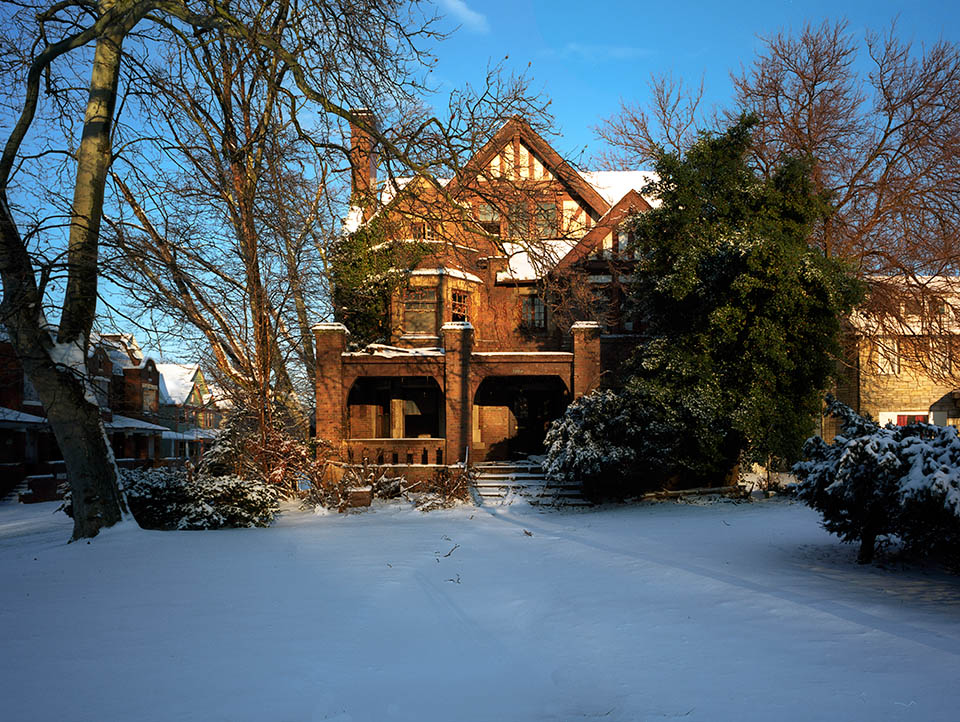
The John T. Gill home, Euclid Avenue in the once swankiest section of East Cleveland. Mr Gill was a builder and he built, amongst many structures, The Terminal Tower, tallest building in Cleveland until 1981. The family built this home in 1903 and moved out in 1915. There were a succession of owners including funeral homes between 1930 and 1970, when these old mansions had become Cleveland’s Funeral Row.
It was finally torn down in 2011.
Much of the rest of the architecture of EC is a grand, sometimes absurd, mixture of many styles but never modern or contemporary or even art deco, with the exception of the Forest Hills ranches. Giant Tudors, columned colonials, massive brick or wooden mansions or mixtures comprised the big homes, while bungalows of all types, duplexes, row houses and every kind of single-family home – gothic, tudor, colonial and especially Victorian, fill the city. Many elegant and classy homes were built oddly, perhaps in retrospect and, combined with the general organic descent look more odd. And, for some reason, staircases in East Cleveland were always grand affairs, with the abundant use of now rare woods both inside and outside the homes.
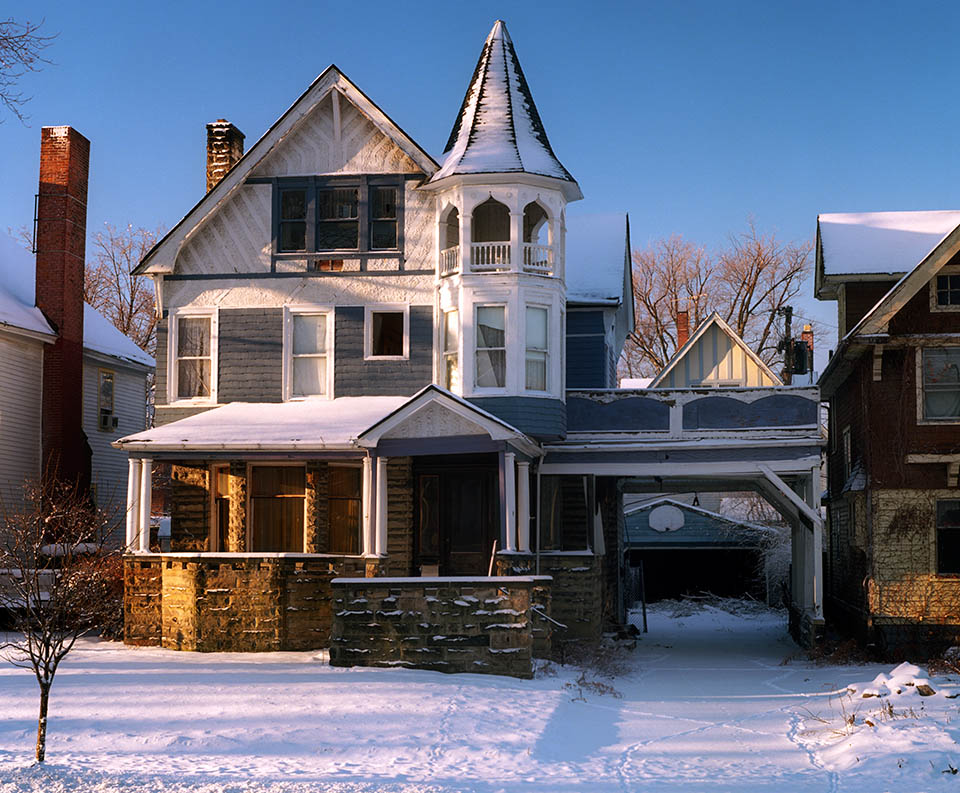
This house on Idlewood is about 100 feet off Euclid Avenue and mixes a lot of architectural styles. It was demolished in 2012.

The house had the usual grand staircase and exotic woods. The fireplace is made of carved stone and brick. I remember the door handles being works of craft art. I don’t take pictures, too much of door handles.

You can still buy a new piano at Kay’s on Euclid Avenue, one mile away. Cleveland’s only piano store is, ironically, still in East Cleveland.

A man walks home from Euclid Avenue down Chapman Avenue – it’s completely lined, with abandoned apartment buildings, that have been let go for 20 years, so the flora is left to go wild and unmaintained.
Like Yonkers, the first American suburbs included sections for middle class and working-class as well as the wealthy who often founded these places. In fact there were by far more working-class folks in EC than anyone else as the better homes were all from the top of the bluffs down to Euclid Avenue, but were entirely single family.
Here on Chapman Avenue both sides of the street were lined with large apartment buildings with many one and two bedroom units, much smaller than the normal generous square footage of Rust belt cities, but decorated finely within leaded glass, tile roofs and rare woods throughout the residences. EC was known for abundant, cheap, but classy cribs, as much as its mansions and Forest Hills development.
In 2018 all the wild trees were pulled and in 2019 the city closed the street. This is an example of moving forward, here, for the forst time in many years.
Yes, in the late seventies East Cleveland was one of the classic examples of quick white flight. Tempering that, with the fact that during its time, there was also suburbs with newer, cheap and abundant housing the next suburb over, but also that was 40 years ago, and there has been succeeding generations of folks who thought they had an answer, none of whom, were the accepted power villains of our times – white folks.
Sad Facts.
The population peaked at 40,000 and stands at 17,000 today, with closed factories, low property values, little tax flow and high safety demands and you have the most compelling urban problems with no tax base pointing directly to a fleeing population. For a couple of years now the city has just kept cutting services, while looking for solutions – one is annexation to Cleveland.
If you wanted a quick introduction to what East Cleveland is known for, check the East Cleveland fire department’s EMS website which featured numerous graphic shots of car accidents, gunshot wounds and stabbings. It’s the most real website that i have ever seen. (http:eastclevelandfire.tripod.com/id14.html) As if fire and rescue didn’t have enough challenges, by 2015 the trucks were of no use and needed repairs and replacements there was no funds for.
Back in 1911 when the village had become a city and a professional team of firefighters was hired, the new-fangled horseless fire trucks were made in Cleveland by Winton which began building cars in 1897, it was all there locally. It was the best location, not for vacationing, but working hard and having a nice place to live.

The top floor of the assembly building at the old Chapman Auto Works on Taft Avenue. This and most all of the remaining structures were demolished in 2006.
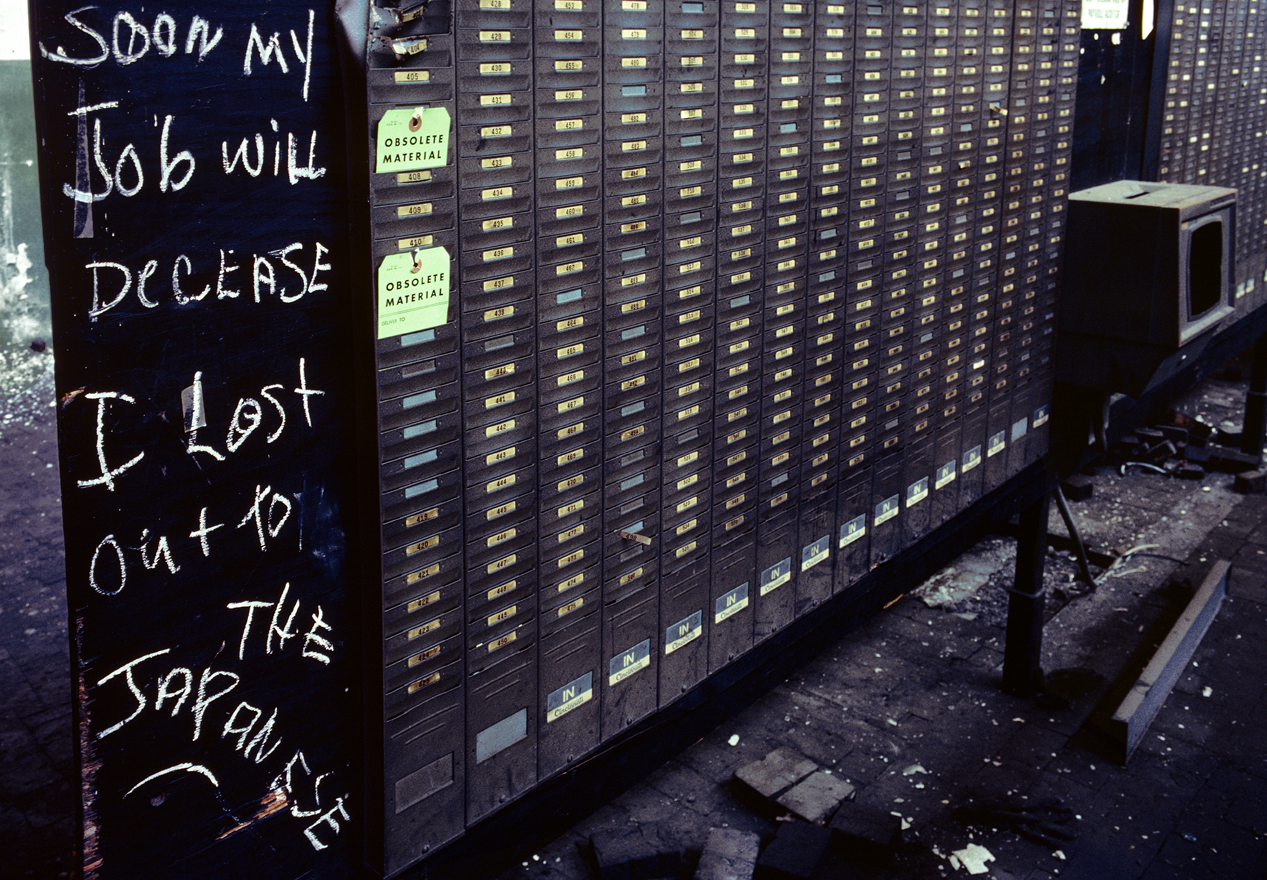
Time Clock, Fisher Body Plant, Coit Road. Just down the road from the National Acme Plant was this Fisher Body Plant. Both were in Cleveland but blocks from the East Cleveland border, and many folks from EC worked in these factories.
GM finally demolished this plant in 1988, six years after closure.
Within its 3.09 square miles, East Cleveland’s population has fallen dramatically over the years, from a peak of 40,000 in 1970, to 36,957 in 1980, to 33,096 in 1990, to 27,097 in 2000, to the most recent census figure of 17,843 for 2010. Eight years later, things remain worse. EC was white in 1975, and was the fastest flip to an entirely black city i have seen to date.
Today its median household income is $20,660 versus $48,849 statewide, based on median taxable income, the East Cleveland school district, which includes a small portion of Cleveland Heights, has the lowest income in the state.
Poverty rate: 42.1 percent versus 15.9 percent statewide, with its children in poverty at a rate of 60.2 percent versus 22.7 statewide. Its median home value (county appraisals): $36,900 with a vacancy rate: 37.1 percent versus 11 percent statewide, with renters being 64.8 percent of citizens versus 33.1 percent statewide. Households with no vehicles? 38.7 percent versus 8.4 percent statewide.
The Reality.
Parts of East Cleveland were considered very desirable places to live, and the city itself is a magical odd mix of architectural styles manifesting itself in mansions, row houses, large old apartments buildings. The staircases inside many E C homes were stunning, big open affairs. There is and was enough fine woods lining the interiors of these homes, that one can understand the rarity and restrictions of many hardwoods today. (and it’s got nuthin to do with dead trees)
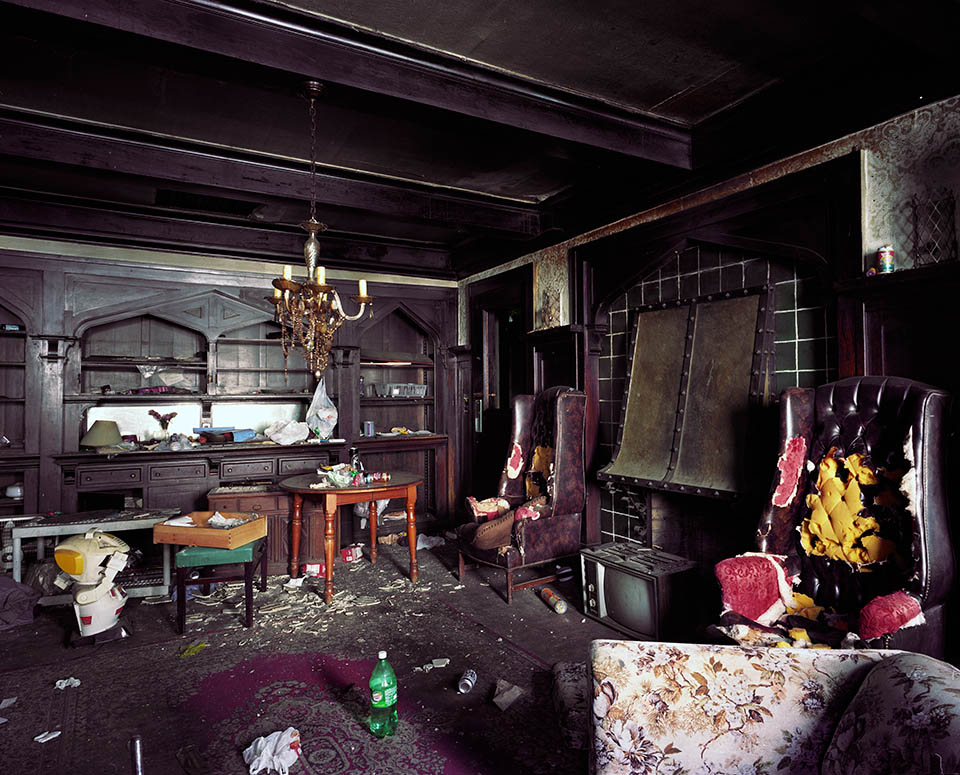
A home just off Euclid Avenue – a Tudor that was decked out from top to bottom in prime woods.
The reality is that East Cleveland has fell hard and steadily since the late eighties, further than any city in Ohio and that’s the perception of it because it’s true. People who don’t live there, only drive through it, and with its infrastructure and snail’s pace roads, people mostly drive around it. It’s not a destination, and if you are not one of the many long-term residents, it’s the second last station on the line or the only place found that is affordable. As a place in most folks’ minds it’s too dangerous to even stop. It’s a phenomenon that goes a long way to make people avoid driving through East Cleveland at all. Can you imagine cruising up a street late at night, the street lights are out, and there is no sewer cap in the middle of the street. And for the people who live there it’s a daily grind. Navigating the streets requires manual vehicular slalom skills to avoid expensive repairs. One day on 152nd Street i watched a sad theatre of bent rims, broken axels and flat tires while shooting the holes there, and wouldn’t ya know it, a guy had a garage right there, and did a lot of work.
People considered my actions a bit heroic, i was often thanked for my action in documenting this outrageous level of deterioration.
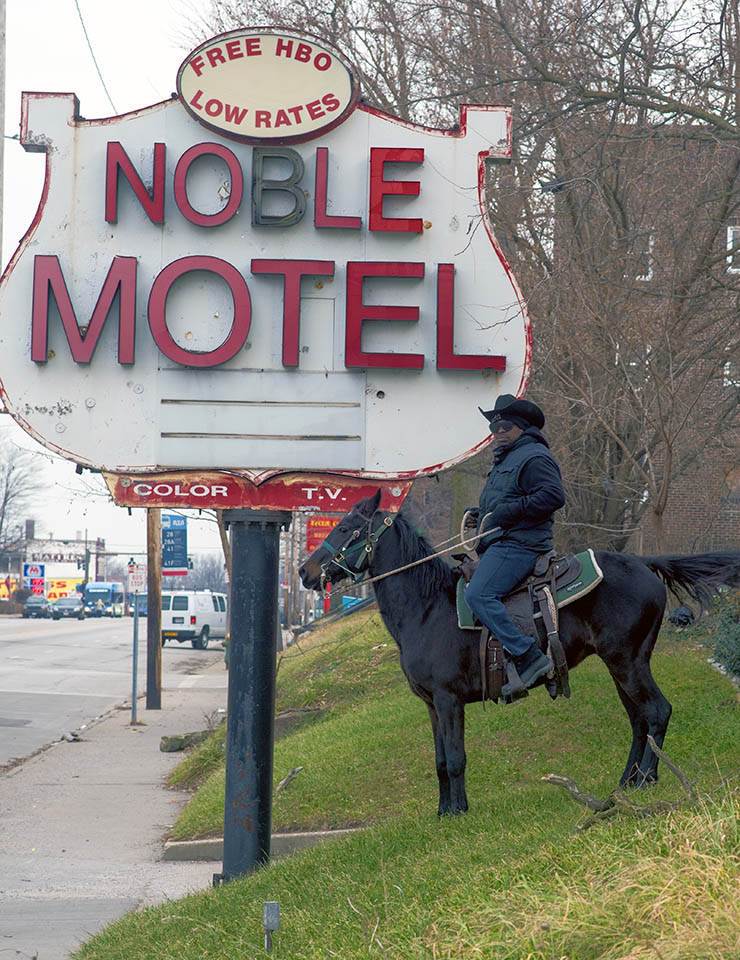
It’s the wild east and Main Street is Euclid Avenue and it is the responsibility of each citizen to maintain law and order. Liberal conceal and carry laws help too. The Wild West atmosphere, unfortunately attached to EC, must be met with a grain of salt and a sense of humor, by the locals who really got their shit together, like Damien, who, along with a sense of humor, brings a horse.
EC has identity and pride of place. There’s evidence of this on every block where folks still live long-term on streets where so many homes are abandoned, gone or ruined. But no where is EC’s identity more demonstrated, than in its voting to reject becoming part of the city of Cleveland in 2015. With basically a no-maintenance city – sacrificed to keep a police and fire presence – whose massive number of severe potholes, is such a low priority, that it got to this level.
A hard core population of working-class folks, many with deep religious roots can be found around the ruins. It’s easy to spot a woman who worked GE for forty years, or people who worked at an auto plant close by in Cleveland, their old homes are completely kept up. When they hit EC in the seventies it was a big step up and out of the Cleveland duplex scene, and into a place whose buildings looked classy and permanent, and you could be very close to your work.
Scrappers grab street signs, as everything is so picked over and scrapped out. The weird thing is that for years the city like the scrappers has dealt with the long exhaustion of revenue sources by cutting, until there’s just about nothing left.
“East Cleveland is in a class of its own,” Ohio Auditor Dave Yost told Scene in a phone interview. “They’re in fiscal emergency, and nobody’s had the size of structural deficits that we’ve seen in East Cleveland, nobody’s had them going on as long, and no city has done as little to correct the problems” One month after Forbes’ interview, Yost’s office blasted East Cleveland officials when the latest audits showed that the city had run a $5 million deficit in 2012. Its situation with the state was escalated from “fiscal watch” to “fiscal emergency.” It was familiar territory; East Cleveland was previously labeled a fiscal emergency for 17 years, from 1988 to 2006. Ohio has never had a city enter bankruptcy – Cleveland defaulted in 1980, though – but East Cleveland is hurtling toward that designation.
City of Dysfunction
East Cleveland boasts a string of mayoral blunders for the history books. There was Sarah Goggins, who was pinned with a manslaughter conviction in the ’80s for stabbing an ex. There was Emmanuel Onunwor, who raked in more than $70,000 in bribe money and now sits in federal prison on corruption convictions. And there was Eric Brewer, the former journalist turned politician who ruled East Cleveland with a mean streak before losing to Norton in 2009 by a 2-1 margin after photos of him in lingerie spread like wildfire across the city.
A history and string of corrupt, convicted and jailed mayors, and other mayors who weren’t jailed but had to slink out, like EC itself, were all characters in their own right. From the bottom, its streets and its top, its mayor, it’s been bad. It would stand to reason that there would be a troubled history with the police department, particularly in narcotics, but also in more basic stuff, like traffic violations. Here’s some background:
https://www.cleveland.com/metro/2021/09/police-pursuits-rampage-east-cleveland-terrifying-residents-and-theres-no-move-to-stop-them-east-cleveland-police-chases.html
https://www.cleveland.com/crime/2021/08/in-the-race-for-east-cleveland-mayor-police-chases-underscore-candidates-differences-and-city-dysfunction.html
https://www.nbcnews.com/news/us-news/rogue-east-cleveland-cops-framed-dozens-drug-suspects-n736671
https://www.cleveland.com/metro/index.ssf/2017/04/east_cleveland_police_officer_3.html
https://www.youtube.com/watch?v=kCH8W7WDIbg
So far there hasn’t been an outside or ivey league-educated, live-like the-people politician looking to make a name for themselves, like in Braddock PA or with Corey Booker when he was in Newark.
Going back to the mayors, and some details about one of them:
The Nigerian-born Onunwor won his seat at as the head executor of East Cleveland on a platform vowing to oust city politics of corruption, and stood firm against the racketeering and corruption charges leveled against him, but was convicted of taking bribes and two counts of tax fraud in September 2004. He was sentenced to nine years in prison and ordered to pay $5 million in restitution on the corruption charges. In a bizarre and tragic twist, Onunwor’s son, Clifton, killed Onunwor’s ex-wife and the son’s mother, Diane, with eight gunshots in September 2008. The son is imprisoned.
Here’s a detail from former mayor, Eric Brewer’s personal life that was violated and won’t be helped by my use of what’s questionable on a privacy level, and helped him lose his re-election. Relatively speaking he was actually a pretty good mayor:
I distinctly remember the streets of EC in 2004. The open air drug dealing, ‘hoeing and crimes were hitting such a crescendo that the county sheriff’s department had to come in and facilitate, which eventually, by 2007, calmed things down to a more simpler mayhem and chaos, and things got a little cooler. Even today, with all the renewed lack of resources, the city limping along, the crime hasn’t been effected, it’s still there, of course, but folks aren’t doing any extra flipping over it. No one has pulled a gun or threatened me too much since 2007, and the city’s finances have gotten much worse since then. EC is still perceived as the ultimate danger zone for some good reason, but is still hanging in there.
EC has so many negative tangibles to worry about, but those are all connected to how its perceived by, for instance, the neighboring police forces, media and citizens, let alone myself who, out of all these folks, has a vison of EC more aligned with its experience.
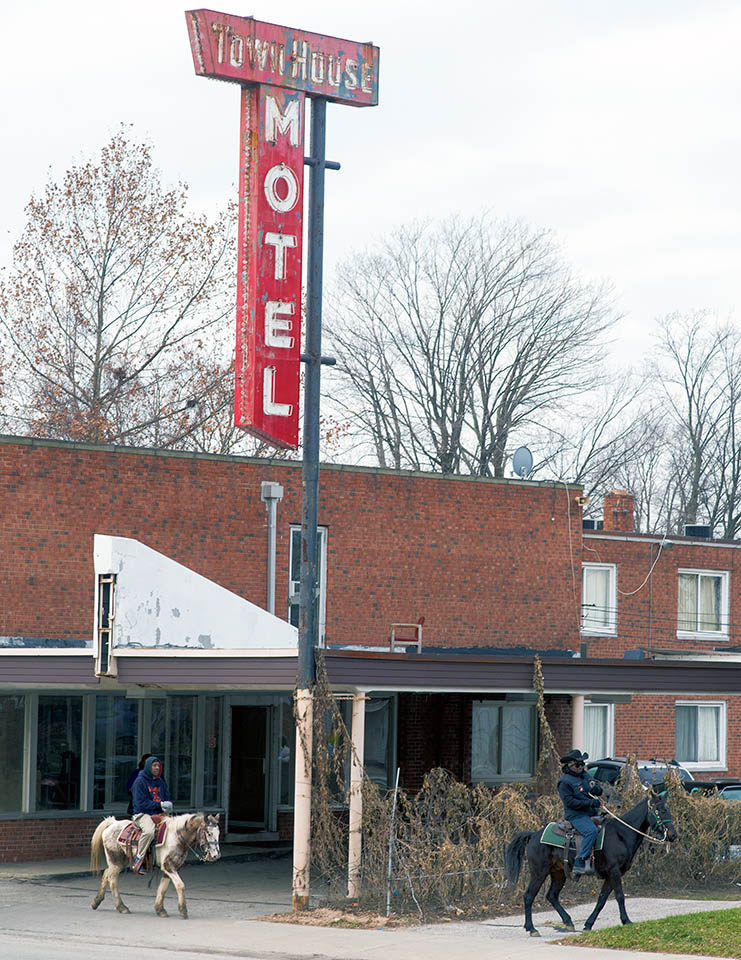
The pothole situation has made transportation by train or horse, once more, a viable option, and, here, along a long-time outlaw, half-abandoned, cheap motel strip of Euclid Avenue, Dame, on the lead horse, recreates the era when all traffic on Euclid Avenue was horse driven, like the man that fueled the automobile more than any other, who was an avid and skilled horse man who drove himself to work at his Standard Oil headquarters by horse and carriage right down Euclid Avenue. from East Cleveland every day.
“…it wasn’t long ago a gang of them ran roughshod into a residential neighborhood of our city and shot 137 bullets at two unarmed citizens.” E C is the place that two suspects were chased to, from downtown, cornered, and died in a volley of 137 bullets. The city of East Cleveland took the supervisors of the Cleveland police and put them on trial, but not before East Cleveland’s law director offered to not pursue misdemeanor dereliction of duty charges against five Cleveland police supervisors if they each agreed to pay the city $5,000 – “extortion,” as an attorney for one of the supervisors described it. This is a city of desperation, not no hope.
In the words of someone who, for a very brief time experienced the streets of EC, “When you get people who are not really educated on how to run a city,” said Gezus Zaire, a filmmaker who spent a winter recording the documentary Operation Save East Cleveland, “then the smartest of those people figure out how to take advantage of those other people so they can suck it dry.”
That dysfunction and smalltime power shifts get mixed with boards that operate basic city services, like the board of the East Cleveland Public Library.
It’s not as upfront and all too iconographic as the physical shape of the city itself, but that’s because the holes in EC are the results of the dysfunction, and, its residents who must contend with a city in the hole for too long, have no other choice, and, overall the hole of East Cleveland is essentially dysfunction.
So far there hasn’t been an Ivy League educated, live-as-the-people politician to make a name for themselves by moving to the country’s most distressed locations like in Braddock Pennsylvania or in Newark with Cory Booker.
It’s a site of dysfunction and every day desperation but not a city without hope. What Detroit is to the nation, East Cleveland is to its neighboring suburbs and probably much of Cleveland as well. But just like Detroit, if you live there, with regards to others’ perceptions of you, it don’t mean shit. Particularly if the local infrastructure keeps everyone out who might otherwise know what it’s really like there. It’s basic geography and timing (history) – if Cleveland’s east side wasn’t bad enough, which it is, the next city to the east is E C, and it is worse. It’s worse because it was the first of its kind and kept too much city in it. It’s a suburb that was offered twice in the early 1900s to join Cleveland and did not. Why? It’s trajectory began with Cleveland’s top industrialist, who would become the first billionaire. Where do you go after, the richest man in the world splits?
Interesting politics, if fractured and dysfunctional to the extreme is your thing, but it’s nothing more than a reflection of what has seeped into EC over a very long time.
So far there hasn’t been an ivey league educated millennial picking East Cleveland as the place they need to be elected mayor to finally turn it around. East Cleveland has drawn on its own all along, and it’s elected office was never seen as a stepping stone up in politics, which would probably prevented anyone who runs from being elected in the first place, and also reinforced by the fact that so many former mayors went to jail or had some absurdly East Cleveland event end their budding political careers. Perhaps its original sin through the county auditor, and the local government – taxing Rockefeller when he had the best excuse in the world – his wife was too sick to go back home to their legal home in New York, and she couldn’t do so until she recovered, a matter of months – never spoken much about, would manifest itself.
And speaking of monopoly moguls – if one big tech company would set up shop anywhere near EC they would have some of the cheapest housing in America (not in EC, that would be the cheapest houses in the world, but its more eastern neighbors), cheapest utility and gas rates, and governments more than willing to do the opposite of what they did to the first and biggest monopolist 100 years ago. And the local work force is just plain too willing and starved out of any progress for so long, that they would be the ideal hungry workers.
But did Carnegie, Gould, Daly, Morgan et al, in their day, want to depart the centers of finance for the emerging west coast, or put their mills in there where transportation and fuel costs alone are the highest, but the weather is great?
If you weren’t from Cleveland when crossing into East Cleveland it would be hard to notice since Cleveland’s Glenville section is one of Cleveland’s poorest and gun-ridden. But on the other hand the other borders of East Cleveland are the inner ring integrated suburbs where many of the residents of East Cleveland who can, have moved to. East Cleveland fell much further than the east side of Cleveland has fallen, and cannot reverse. Cleveland is big enough to have sections that are now booming, whereas EC has no real downtown – its main drag just runs for four miles along Euclid Avenue. But now it’s fall has gotten down to the most basic infrastructure problems.
While the southern end of the city had fine homes, including Rockefeller’s son’s Forest Hills development, East Cleveland south of Euclid Avenue had streets of large apartment buildings, row houses, duplexes and many types of single family homes. Nearby factories in Cleveland, within walking distance of East Cleveland were some of the city’s biggest employers, and you will find numerous older citizens who are now retired from local industries, having bought homes and spent their lives in the city. And, for those folks, commonly working, even fifty years before retiring from GE, Fisher Body, GM, National Acme, Reliance Electric, Bailey Meter, Atlas Car, Conrail, etc., nearby where they live. The places they used to work are closed, gone or even worse, as many become dumping grounds, sanctioned as turning dead factories and brownfields into recycling centers, but are merely the last sad chapter in this regions’s industrial history – a sad ending, where huge plants that employed thousands for up to a century, end up as a site for toxic waste crimes, that are perfectly set in the long forgotten lands of a city where people still live, and no one on earth cares about.

The long abandoned National Acme Plan built in 1916 at the corner of Coit Road and Taft Avenue. It was slowly closed during the eighties until the company only maintained a storeroom. By 1993 it began its undisturbed organic descent until 2012 when it was bought, illegally demolished (no remediation) and became an illegal dumping ground.
Next to the old Chapman Auto Plant and blocks from the Fisher Body Coit Road Plant, National Acme was another company with thousands of well paid union workers, so much so, they could afford to move out of Cleveland and East Cleveland and into a suburb.
General Electric still has an operating presence in East Cleveland with the Nela Park facility, considered to be the first industrial park in America, and it owns huge tracts of land with long closed but standing factory buildings, as well as, land where closed and demolished factories once stood. There was a large lamp plant off Noble Road just inside the EC border. The plant eventually was demolished and the land given to the city which allowed a company called Arco Recycling to use it for just 175k as a recycling facility where the debris from hundreds of the demolitions going on in Cleveland can be processed – for $175,000.00. Of course it was merely a dump with little recycling, that eventually grew so high as to overshadow the line of duplex homes on its west side. Eventually underground fires would erupt. The dump emitted smoke (toxic) while leachate streamed from beneath the piles of debris saturated by the water thrown on it to quell the fires.
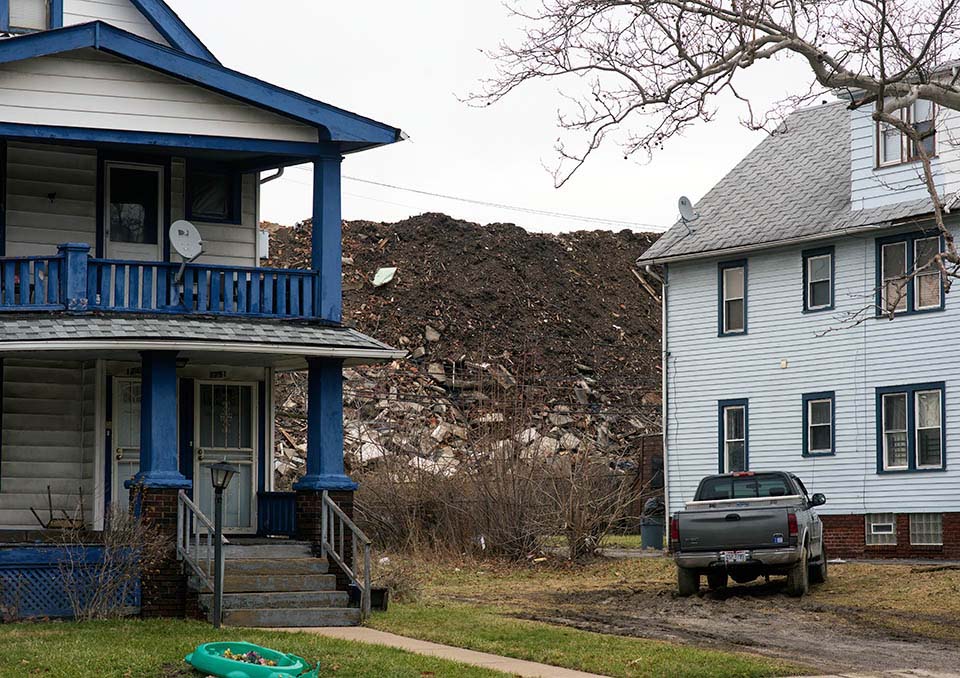
Imagine sitting in your kitchen table at a window and seeing this, where, at worst, General Electric simply had a large two story non-polluting lamp plant, with a large buffer parking lot, that then sat vacant for many years in undisturbed organic descent from1982 until 2017 with the dump’s closure. The situation, still resolving itself over time – the dump’s owner was convicted for his crimes and the original i am gonna fix it mayor, Norton, lost his job. It cost six million to remove the mess that the mayor sold for the price of 175k – about the price of a one-bedroom condo downtown in millennial heaven.

Out here, where people bust their ass trying to keep up an old home, mountains of toxic waste suddenly appearing is literally overwhelming.
It’s not unusual for places to flip completely on a race level, with EC no exception, but it moved fast. The second great riot and uprising in the sixties was in the Glenville section on the EC border, motivating folks to move, but that also included blacks who wanted a stabile safe place, remembering that available new homes were everywhere in the neighboring fellow suburbs to the east and south of EC. The way there, no matter the struggle, begins with a good job and money. The inner ring suburbs of Cleveland Heights, South Euclid and Euclid have good percentages of their populations comprised of former East Cleveland residents.
The years of transition began before and somewhat during the historic initial factory shutdowns that swept the Rust Belt. Nearby factory jobs always were within walking distance and were plentiful, the pay was good, typically union, especially in the bordering Collinwood section whose auto plants, machine tool factories and rail yards required tens of thousands of workers with absolutely no particular requirements beyond ability to do the job for a long time, and they were entirely union jobs. By the time EC became a fully black city, the massive factories that bordered on the Cleveland side had pretty much shut down and many big homes were divided up into apartments and the large apartment buildings EC was known for, were even more the ideal cheap rental, by virtue of lack of market demand and many homes. Buildings sank into disrepair as their demand waned along with the general waning that ruled the Rust Belt for so long, but this was, and, is, worse.
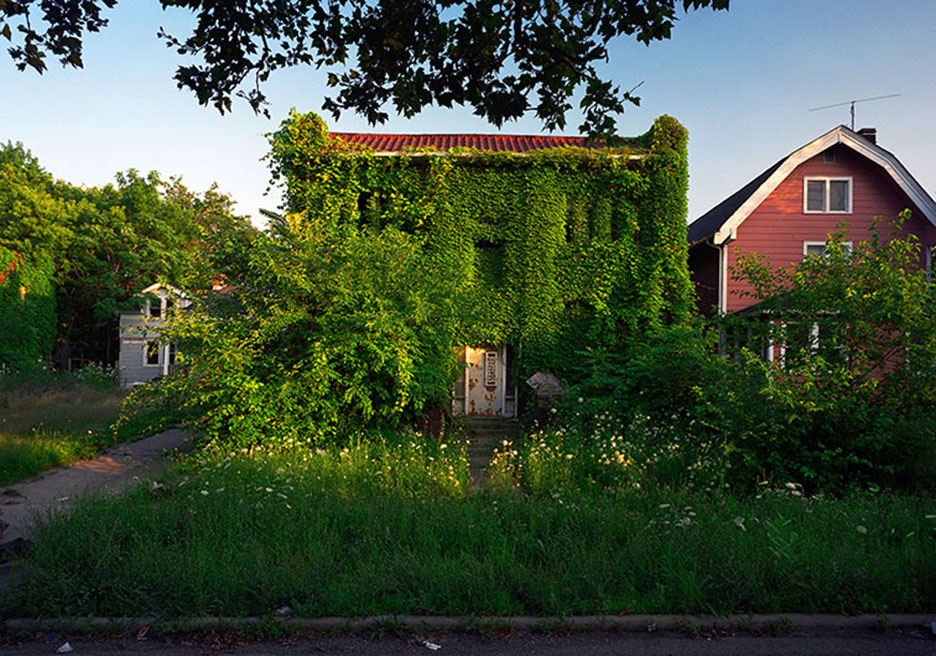
An apartment building on Woodward Avenue within a mile of Fisher Body, Chapman Auto, National Acme, Cleveland Railway and many other small companies that so many East Cleveland residents had found work at for one hundred years straight until the big downturns that started in the late seventies, then, exploded into the eighties, and, then, within every economic downturn, bled that much more.
EC’s overgrown flora has been one of its signature characteristics every summer.
Population is the fundamental factor with distressed towns. With the exception of East Cleveland, which really is not perceived as a suburb, all the inner ring suburbs have high taxes, the highest in the state. When you lose over 60% of the population, it follows that the dwelling, too, will vanish, and, in EC, until the great demolition push beginning in 2010, simply fell into its own organic descent.
EC is in a class by itself, that’s why i lean towards the dump being a phenomenon primarily associated with the economic devastation – a black city of 40 years, run by its citizens, has been consistently ignored or even sold out by their own elected officials. For the price of 175k, a 4 million dollar clean-up followed, and, most importantly, the lives of long-term residents were horribly disrupted, and not in the cool economy sense.
A City Not Far Enough
East Cleveland as, what is now seen as an inner ring suburb, was constructed with housing for all classes. Despite its glorious beginnings with America’s biggest industrialists, EC has always been a place of constant cheap apartment rentals since these dwelling were so abundant. The better sections of EC were north of Euclid Avenue to the bluffs. The area was getting its start because, sitting on the bluffs of the heights, it caught the dominant winds off Lake Erie in the summer years before air conditioning, and the best homes were built there. It also had the best sledding, tobogganing and ice skating due to lake effect snow.
But the other sections of EC were also built well, mixing every available style of architecture from the French Tudors and California ranches of Forest Hills to the Gothic and Victorian middle class homes, down to the worker cottages, bungalows, duplexes and large apartment buildings, most built classically, that stretched out from below the bluffs ending shy of the lake at the Cleveland line. On the east side, past East 79th Street until Collinwood, Cleveland doesn’t get near the lake as the suburb of Bratenhahl and rail lines and a freeway block it. Perhaps EC’s real original sin was including all classes and not, like the suburbs to come, catering to more of a singular class, for it’s sake, an upper class.

Paxton Avenue is typical of some streets that have survived in tact. Lots of home owners, and probably have been there a long time, and show the city’s working class neighborhoods as they were intended – neat, modest and occupied
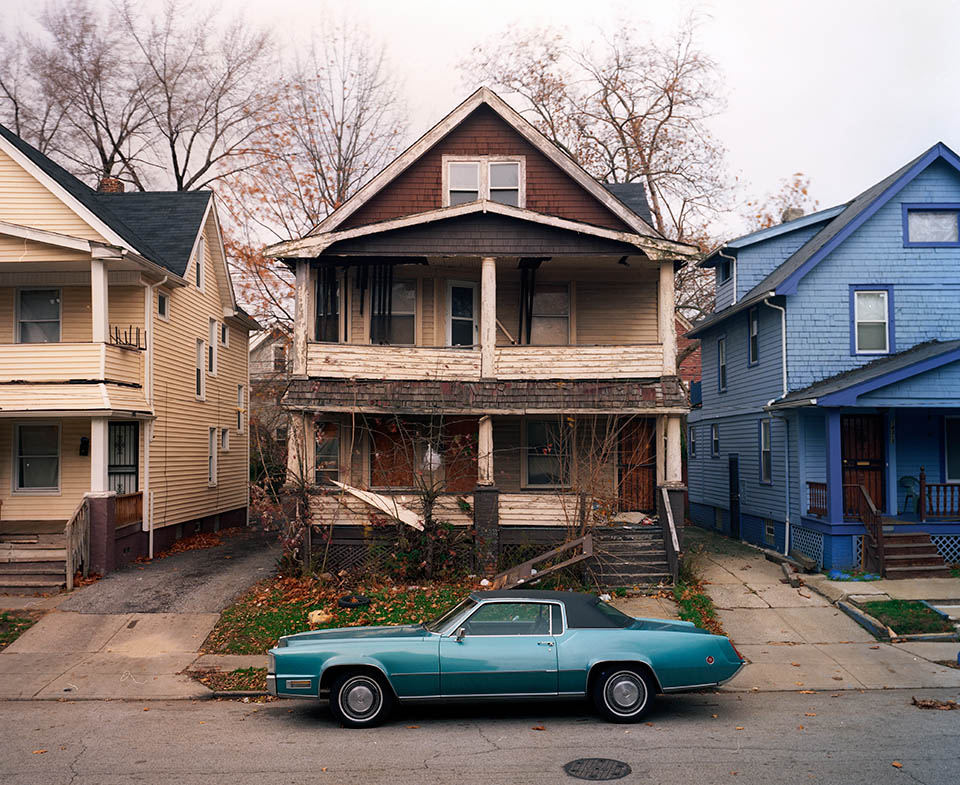
One thing about EC and the east side of Cleveland in general, sixties, seventies and eighties cars are everywhere, and, good chance that parts of it came from Cleveland back in those times.
Cleveland vied with Detroit until the 1920s for car manufacturing dominance, but continued making cars in its own plants until the early eighties when places like White Motors finally closed down.
There are still many parts and even assembly plants in the region, outside the city, and, they too, get slammed and slimmed with every downturn.
This particular ward of the city is filled with cheaply built 100 year old homes, mostly duplexes. A big demolition push took out dozens of homes in 2018. In the old days, someone who worked a mile away at Fisher Body could easily buy a duplex, live on the bottom floor and rent the top floor to someone else, who also worked at the plant, and could walk to work, save money and then do what his landlord did.
After World War II there were plenty of options not far away In the suburbs with new housing, so folks left, and easily sold their homes to the next ethnic group coming through. The difference, though, was the Rust Belt, which by the time East Cleveland became black, was in full swing. Factories hung on but began to close around 1980, and, in a matter of years, everything was gone as far as work was concerned. Old factories were bought, and sometimes divided up, like the old Chandler Auto Plant on Taft Avenue, to lease to small companies, but mostly they sat in their organic descent, except those from really lage corporations like GE or GM that survived the Rust Belt which remediated things relatively quickly. But belly-up companies were abandoned in place.
East Cleveland, always a cheap place to live, north of Euclid Avenue, now became much cheaper, and that was an advantage, for really poor folks, but meant East Cleveland would fall continually, so much so, it fell into holes it could never get out of.
A suburb not far enough – from the city that birthed it. As history has shown, the first suburb wasn’t suburban enough. Later suburbs were incredibly homogenized on an income level, amongst other things. From wealthy ones to working-class, each suburb catered, generally, to a class. EC turned out to be a stepping stone to the actual suburban lands that were all farms when East Cleveland was becoming a population center for Clevelander’s who wanted cleaner air and better housing but still wanted to be close to the industrial city and not too far from downtown.
One of the strangest things about East Cleveland is another transportation related fact. Cleveland’s primary and most efficient public rail system, it’s rapid transit lines, runs through half of EC and dead-ends there across from city hall, in the center of the city, less then a half-mile from Rockefeller’s Forest Hills and is surrounded by cheap available housing and land, much vacant, with cheap utilities and decent taxes, still an ideal bedroom community, on paper, with a direct and quick shot to University Circle with downtown just four miles away. The Windermere station of the RTA was a hub. There’s another station, a large one at Superior Avenue and just over the western border with Cleveland the University Circle and Little Italy sections are accessed at the East 123rd Street Station. All this is runs on regional government and contunually, with constant improvements, right through the heart of East Cleveland.
The city is bursting with both decay and a potential that cannot be determined in the thickets of desperation and perceptions that has surrounded it, and is a hole that East Cleveland has fallen into to the point it helps everyone around it, avoid it, making its own citizens feel more like it’s us vs. a whole bunch of others.
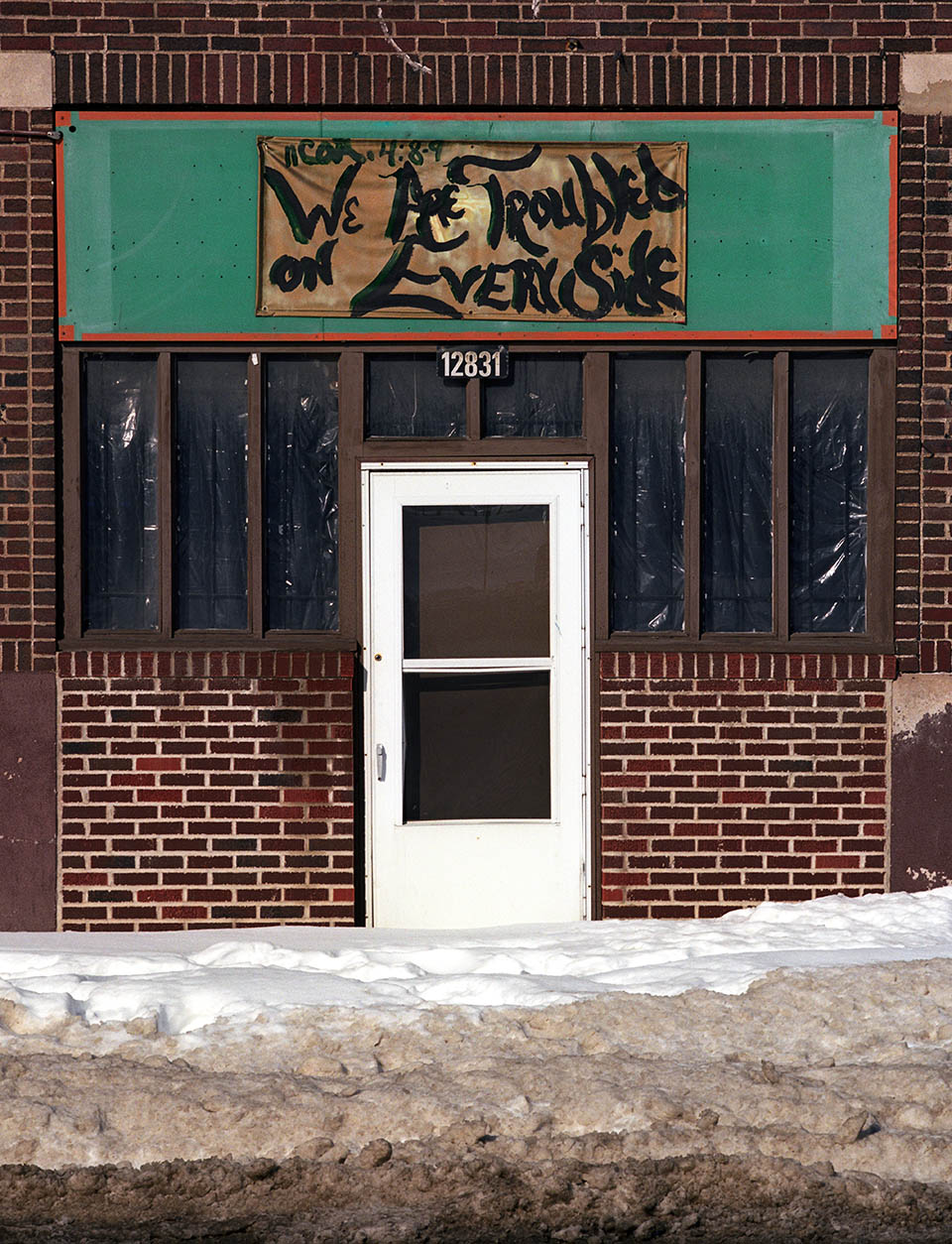
The church, on Euclid Avenue, in the mansion district, closed in 2011 and the entire building of commercial stores and apartments was demolished in 2015.
I’ve referenced the fact that i find suburbanites of eastern Cuyahoga county, like other suburban lands, as living within their own individual worlds. On the macro level each little city in the county is entirely and only responsible for what happens within their borders. Talk of regionalism flourished here in the seventies and eighties, even socialism had quite a grip here in the Mayor Johnson years around 1910, but this is the Second Gilded Age where the action now is on the coasts or in China, and in this age, everyone is on their own. Granted when there has been a fire or other emergency the neighboring safety forces have been there for EC, but outside of emergencies, East Cleveland is on its own. In some ways the suburbs were designed as that – separate sections of like incomes, without pollution, congestion and disorder, or, an enlargement of the American dream – to live safely in your own world, and be able do many things, beginning with the most fundamental principles of quality of life, such as going to work or getting food without damaging your car and getting a one hundred dollar ticket from a robo-cam.
Potholes are fast-changing and fluid, of course some of the holes got fixed and there is always more fresh ones. But East Cleveland is changing – closing off blocks where no one has lived for years and taking out traffic lights whose great number and slowness was meant for a city four times the present size. But you can’t win – in January, 2020, a young girl was hit by a car and died on Euclid Avenue where lights were removed and were supposed to be replaced. A month before another girl was killed on Euclid Avenue, hit by a carjacked vehicle being pursued by police. In 2021 car chases became a daily problem with 66 straight days of chases including quite a few that ended with cars catching on fire and some supects killed by cops, fleeing. And on it goes in EC.
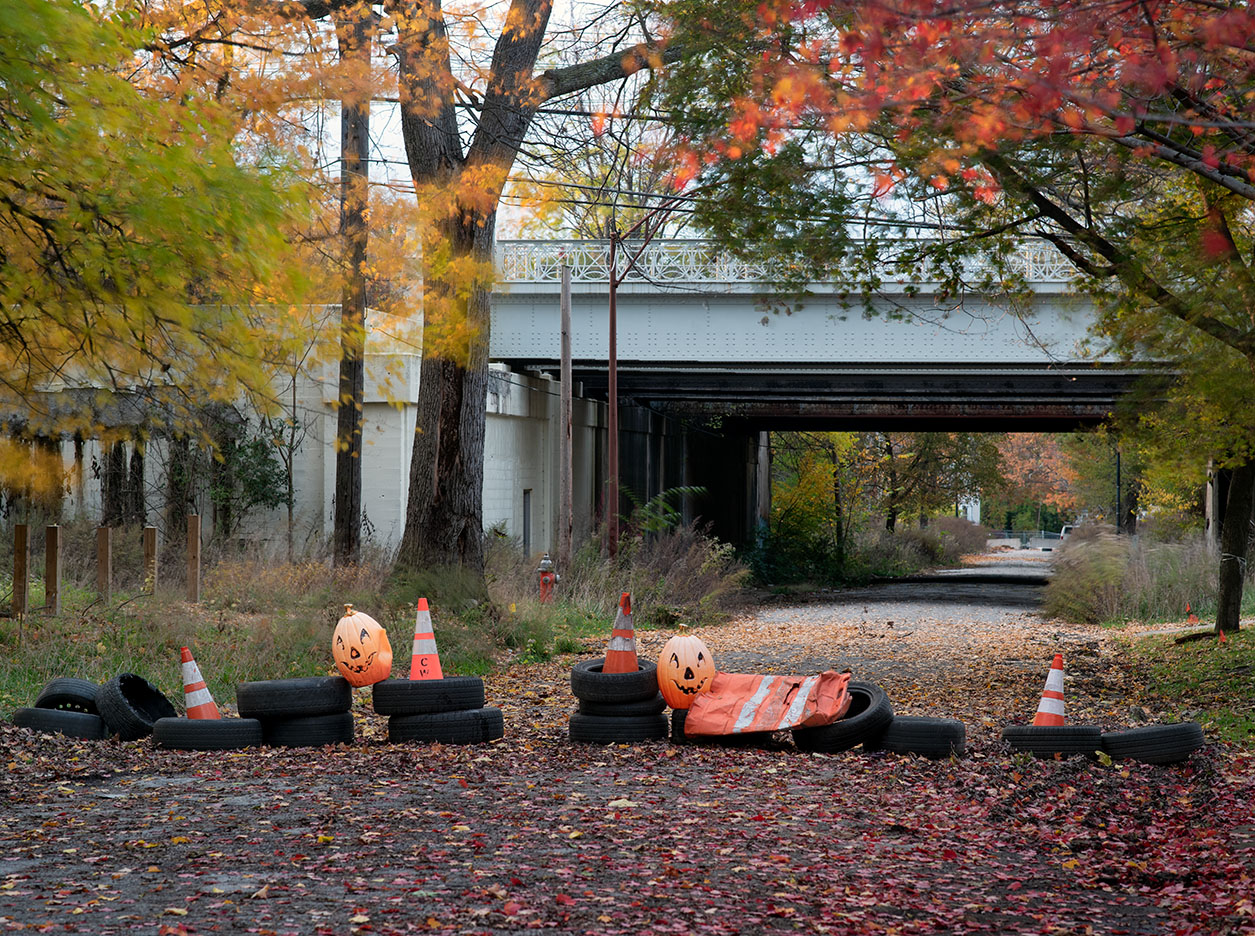

Streets that were once crowded and lined with large homes and apartment buildings, and now might have one to three homes left, were recently blocked off. The tree fell after the closing of the street. Things are changing in East Cleveland, in their own way, of course.
While shooting here two days later, a car stopped and scoped me pretty good and i made the mental note. Two days later the tree was gone. It’s all relative, and, for EC, that’s notable. There are signs now that EC is moving in ways it never did.

In January, 2020, a vehicle lost control, once more, on Euclid Avenue and ran into this storefront which was a charitable organization providing food, clothing and shelter. And another hole is made.
An EC update, in September of 2022. The mayor is up for recall in November, the police chief is going on trial fo extortion, and right after that, two more cops were indicted for accepting bribes, while many cops are in prison already for stealing drugs and money. Then, after these indictments, more cops were indicted for beating up alleged criminals and falsifying reports.
There are 42 police officers in the department, and, in the last year, nine of them have been indicted, and, as of, july, 2023 even more are being arrested.
In Cleveland, one is struck (literally) by three things peculair to this town, because of their frequency – exploding homes, drunk, wrong way drivers on the freeways and people driving directly into buildings and homes. East Cleveland potholes belong to that list.
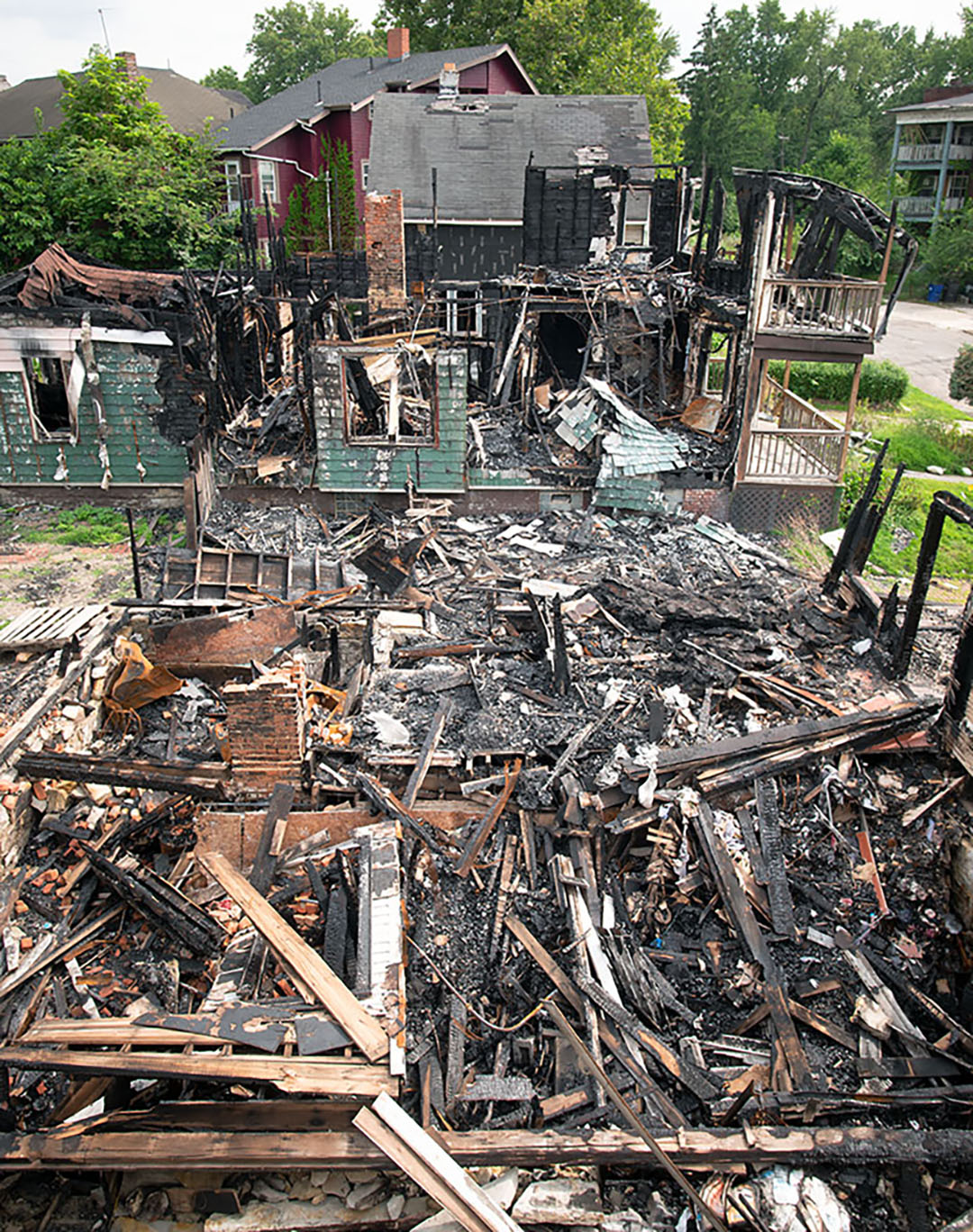
Four homes on 125th Street went up in flames in one night in 2022. Just months before a person died in a gas explosion down the same street.
We’ve looked at one of America’s most troubled cities from the ground up, and found numerous holes, done in a variety of ways, and, asses are asses.
